
Cappadocia
Again, I had no idea what we were going to find during the next two days. Sure, the guide books provided a brief description, but just how much can you reveal in just a couple pages. Nope - was not prepared for what we found. Perhaps the guide books were brief because Cappadocia is very difficult to describe.
When we made our initial stop and saw he white cliffs / walls/ ravines(?) I thought this is fantastic and couldn't wait to see more. They kinds reminded me of the sand dunes in North Carolina. However, what followed was even more spectacular- and strange. Each and every stop was different in its way - each stop was unusual, to say the least.
Below you'll see the descriptions I copped from the Internet and some guide books. I'll keep narrative to a minimum (for me!) because the pictures speak for themselves.
~ ~ ~ ~ ~ ~ ~ ~ ~ ~ ~ ~ ~ ~ ~ ~ ~ ~ ~ ~ ~ ~ ~ ~ ~ ~ ~ ~ ~ ~
Cappadocia, which is unique in the world, is the common name of the field covered by the provinces of Aksaray, Nevsehir, Nigde, Kayseri and Kirsehir in the Central Anatolian region.
In the prehistoric periods the first human settlements had constructed the underground cities in the volcanic rocks in form of tufa due to protect themselves from the wild animals and they lived for long times in these underground cities. There are many underground cities in the Cappadocia area and the biggest is Derinkuyu.
In the upper Myosen period in the Cappadocia region as a result of the volcanic eruptions occurred in Erciyes, Hasandag and Gulludag, in the region was formed a large tableland from the volcanic tufas and together with the erosion of the Kizilirmak river and wind over ten thousands of years there appeared the chimney rocks which are a wonder of the nature.
In the old Bronze Age the Cappadocia which was the population zone of the Assyrian civilization later has hosted the Hittite, Frig, Pers, Byzantine, Seljuk and Ottoman civilizations.
The first Christians escaped from the persecution of the Roman Empire in the 2nd century B.C. came to the Cappadocia over the Antakya and Kayseri and they have settled here. The first Christians finding the underground cities from Cappadocia have been hidden in these underground cities which gates were made in such way in which they couldn't be easily observed and they have escaped from the persecution of the Roman soldiers.
Due that they had live in the underground cities for long duration without being able to go out they have developed these underground cities by making provisions rooms, ventilation chimneys, wine production places, churches, abbeys, water wells, toilets and meeting rooms.
These cities were made of rooms connected to each others tight tunnels, permitting passing of just one person. At the access gates of these tunnels there were huge stone rollers used for closing the tunnels for security reasons.
The first populations of the region of Cappadocia were Hatties, Luvies and Hittites. In the 3000-2000 years B.C. the Assyrians have established trade colonies in this region. The Cappaddocian tables with cuneiform in Assyrian language found at Kanes. The trade and economical agreements are the first written tablets of Anatolia.
According to these documents Anatolia was founded as small local kingdoms, with no central authority. These were small in area, and were living in peace.
The Pers civilization called this region Katpatuka and its center was Mazaka. In 33 BC the Alexander the Great captured a big part of Cappadocia. In 188 BC Cappadocia entered Roman domination having been captured in 100 B.C. by the Mithridatesd the king of Pontus. Then in 63 B.C. Pompeius defeated Mithridates and again Cappadocia was under the domination of Rome. In the period of Tiberius the Cappadocia gained the status of Roman district.
Cappadocia was one of the most important places in the spreading periods of the Christian religion. The first Christians were trying to escape from the Roman soldiers who wanted to avoid the spreading of the Christian religion. Saint Basileious from Kaisera and Saint Gregorios from Nyssa settled in Cappadocia.
Herodotus tells us that the name of the Cappadocians was applied to them by the Persians, while they were termed by the Greeks as "Syrians" or "White Syrians" One of the Cappadocian tribes he mentions is the Maschoi, associated by Flavius Josephus with the biblical figure Meshech, son of Japheth: "and the Mosocheni were founded by Mosoch; now they are Cappadocians". Acts I:6.
Cappadocia is also mentioned in the biblical account given in the book of Acts 2:9. The Cappadocians were named as one group hearing the Gospel account from Galileans in their own language on the day of Pentecost shortly after the resurrection of Christ. Acts 2:5 seems to suggest that the Cappadocians in this account were "God-fearing Jews".
In 647 AD, together with occupation of Kayseri by Muaviye, Cappadocia met with the Arabian invasions. Cappadocia went under the domination of the Seljuks in 1072 and was added to the lands of Ottoman Empire in 1399 by the Ottoman Sultan Yildirim Beyazit.

Cappadocia is surrounded by volcanoes. This one we was as we approached the area.

We started seeing these cuts in the ground, like small gullies.

And these cuts had layers of color
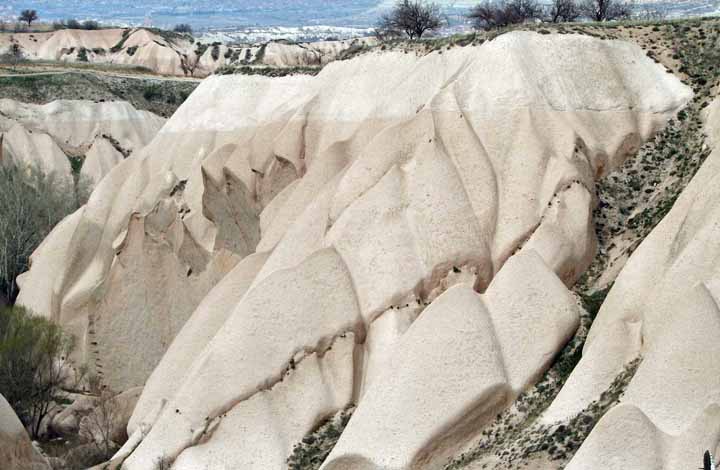
And then we stopped and saw our first up-close view
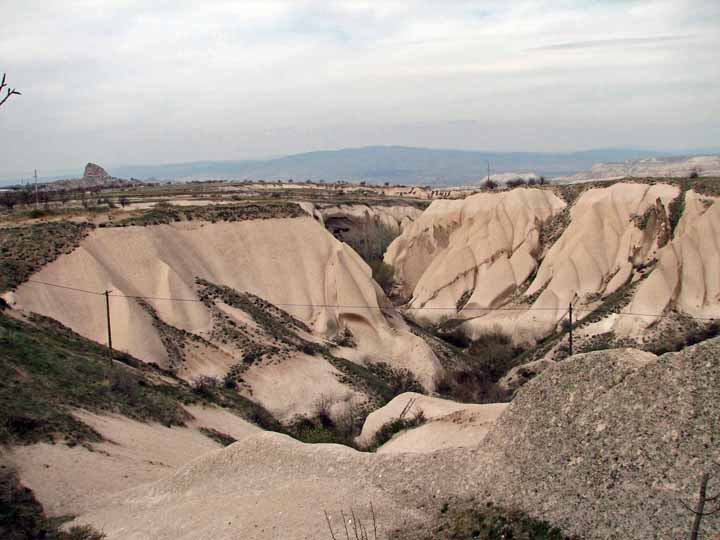
Go ahead - you try to describe it
 And
then we see this! What are we seeing?
And
then we see this! What are we seeing?

THIS is "old town" - this is really "green" living quarters

Up close
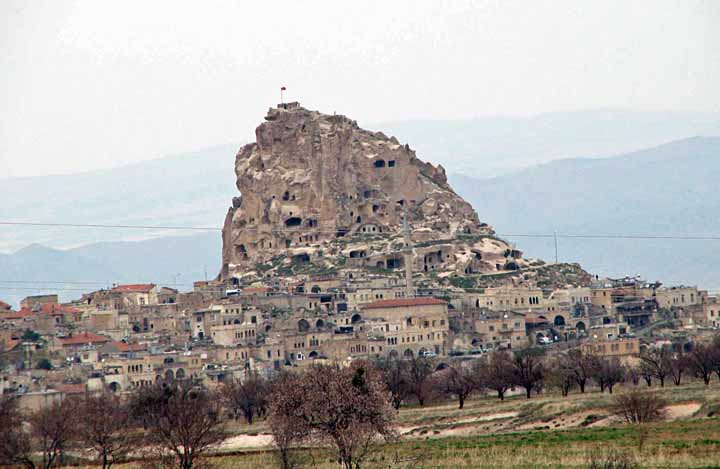
This was described as the "Citadel"
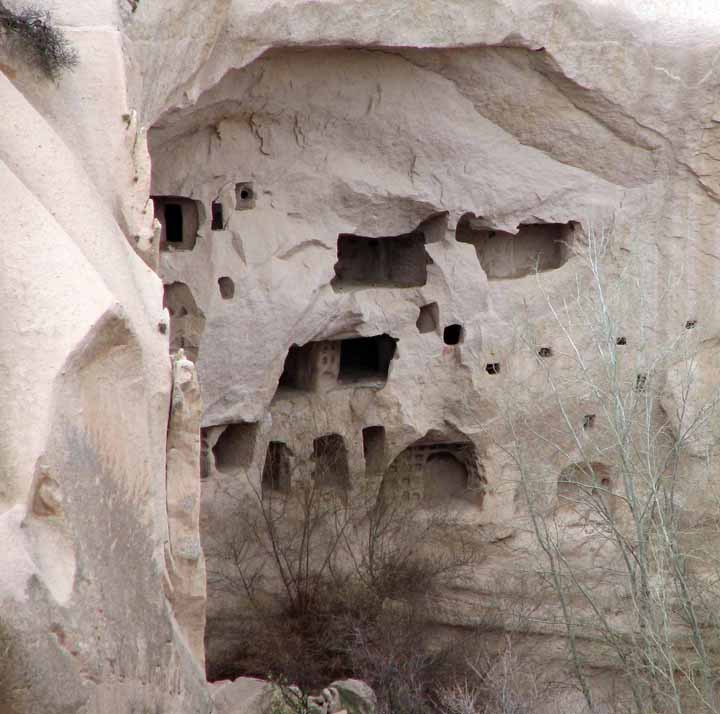 And
we get our first real look at the homes carved in the rock - rock defined as
volcanic rock - lava - which has layered up over tens of thousands of years,
carved out by wind and water.
And
we get our first real look at the homes carved in the rock - rock defined as
volcanic rock - lava - which has layered up over tens of thousands of years,
carved out by wind and water.
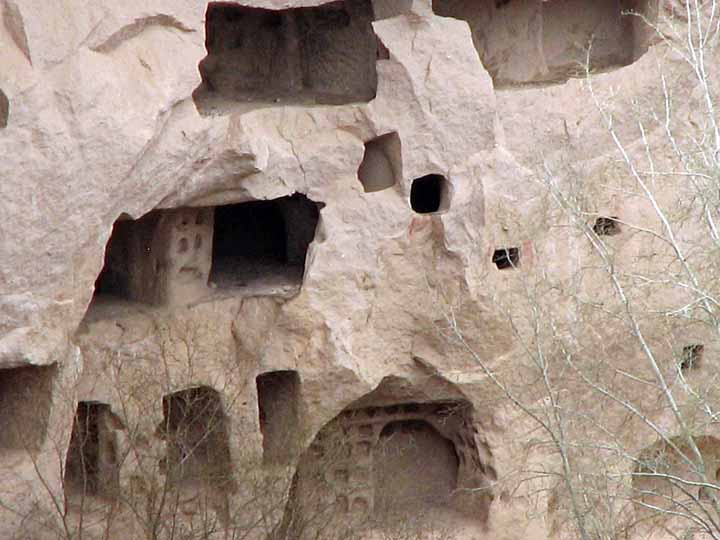
Reminds me of Mesa Verde or Navaho Park
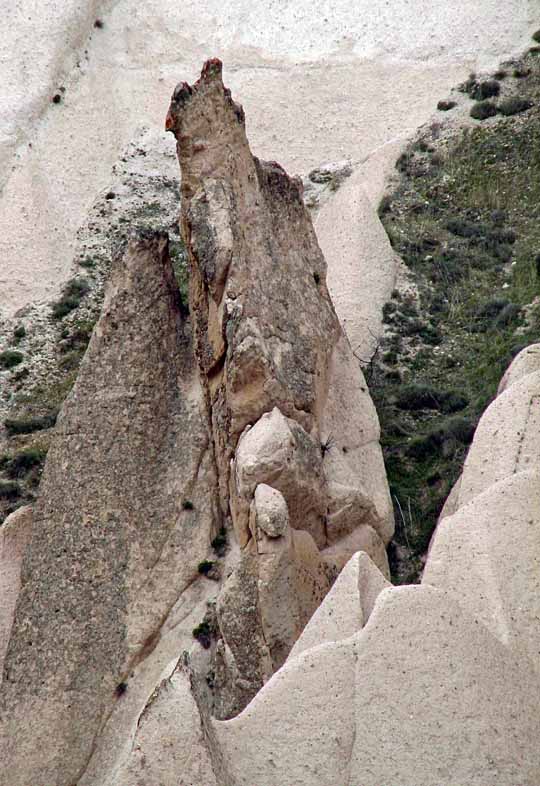 Strange
formations every where.
Strange
formations every where.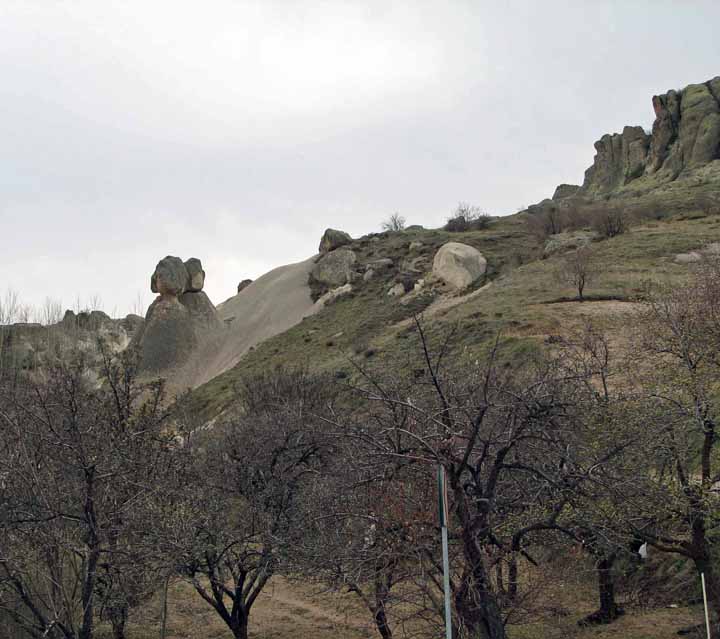
 Layers
of colors
Layers
of colors


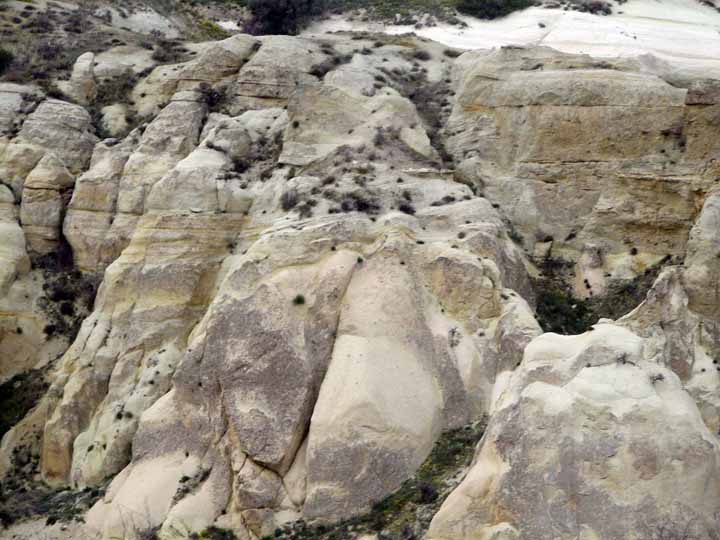
 Stone
homes, churches meeting rooms - all the functions of a community - in
stone. Our first stop
Stone
homes, churches meeting rooms - all the functions of a community - in
stone. Our first stop
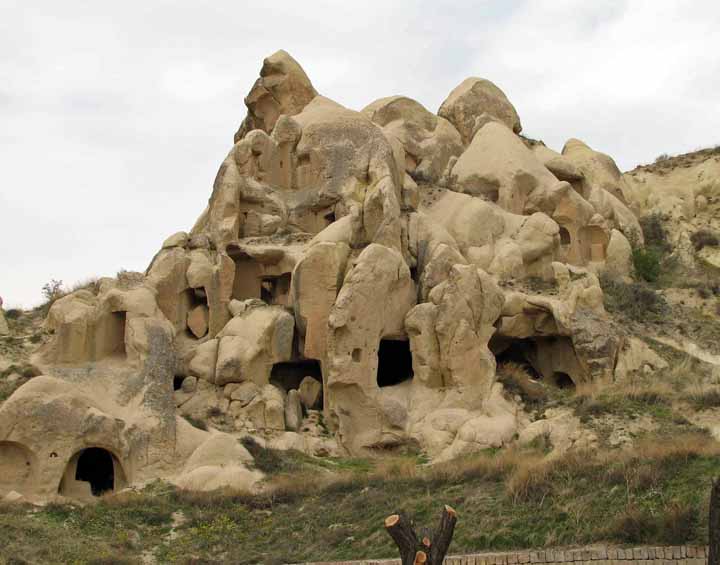
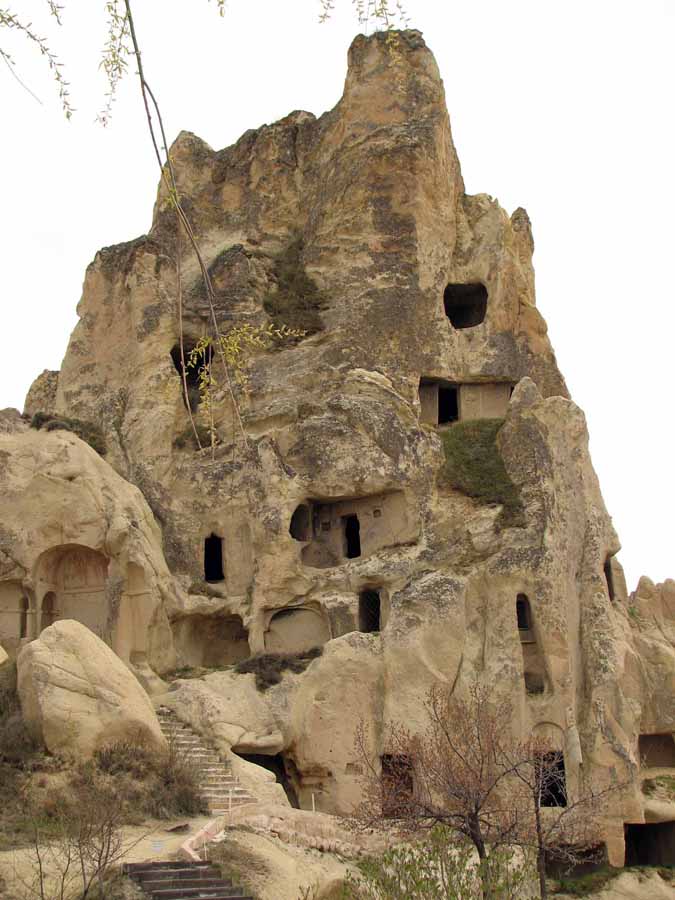 A
convent
A
convent
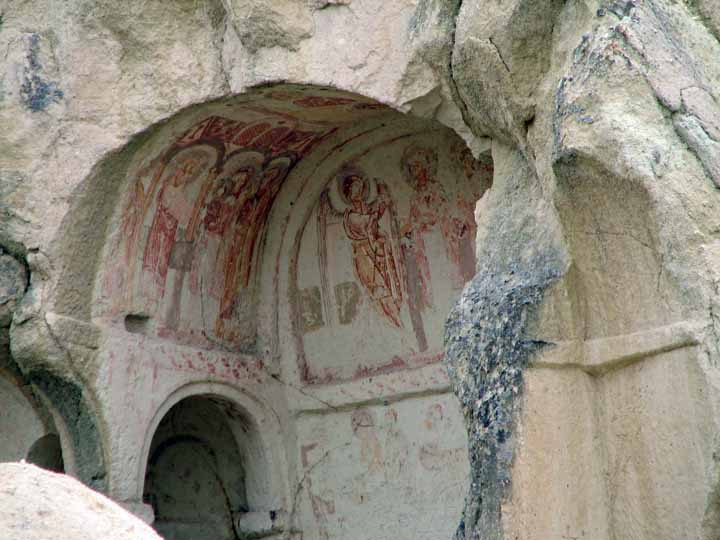
Look carefully and see religious paintings
 The
stairways and passages between rooms are primarily internal.
The
stairways and passages between rooms are primarily internal.
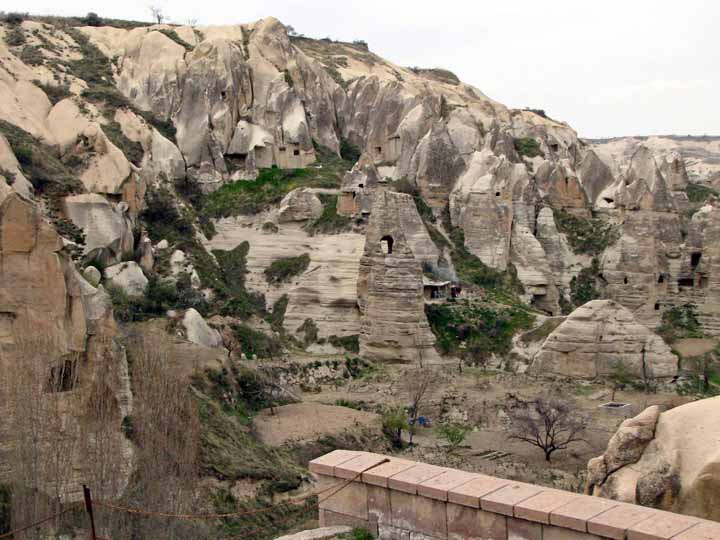
An entire community hidden in rock

 Across
a ravine we see - what is it? Looks like a set of old post office boxes
Across
a ravine we see - what is it? Looks like a set of old post office boxes
 Jackie
doesn't know either. Only later did we find out why there are so
many of these "boxes" and why they are terribly important to
Cappadocia.
Jackie
doesn't know either. Only later did we find out why there are so
many of these "boxes" and why they are terribly important to
Cappadocia.
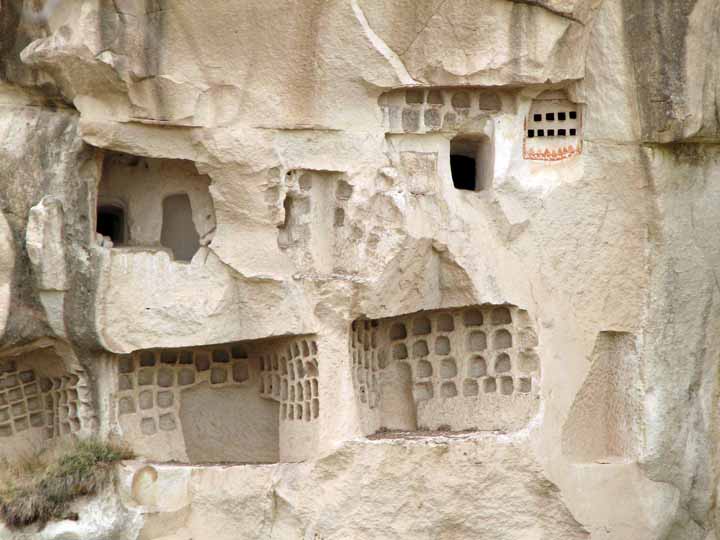
What ever they are - there's plenty of them.
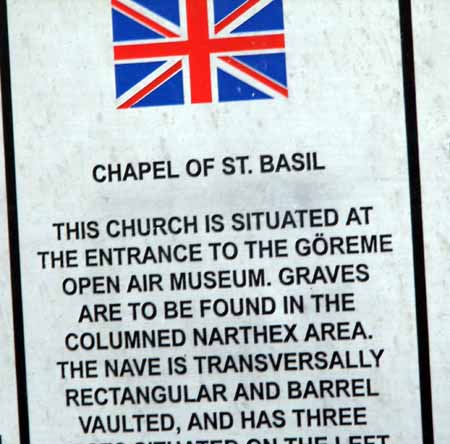
St Basil - get ready for a surprise
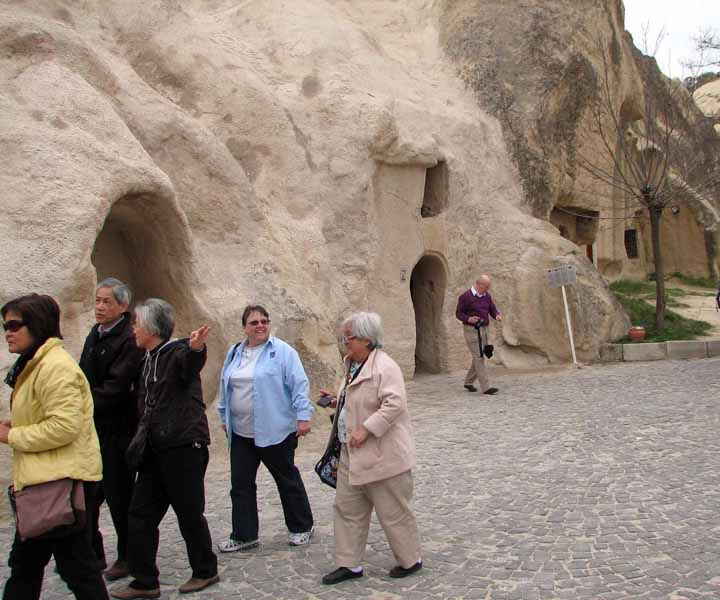
OK - that is strange - given it's a church carved into rock!

The Apple Church - Emali - Now we see remarkable, unbelievable painting on the walls
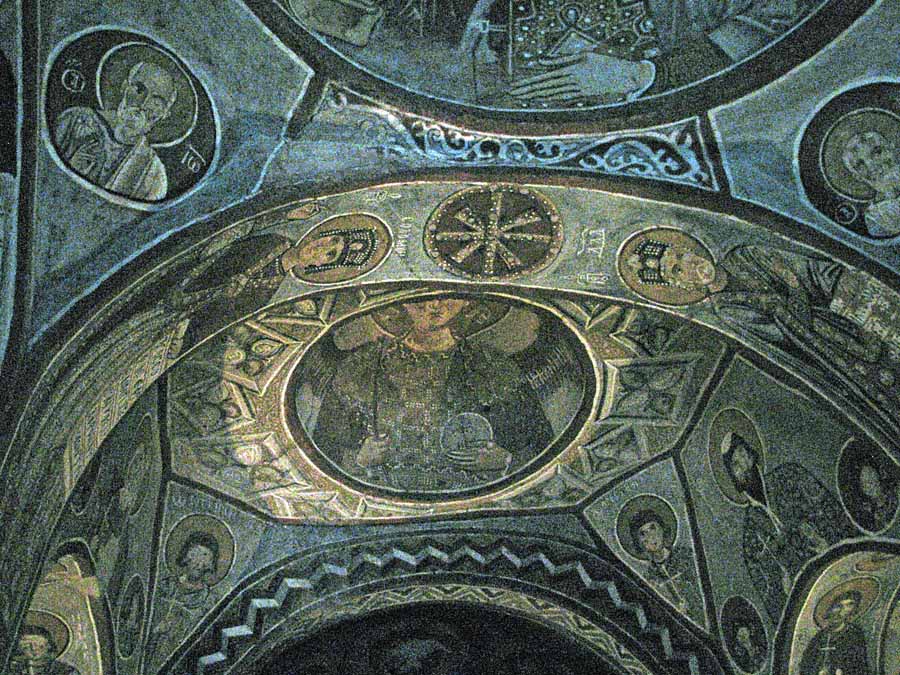
How do you describe this beautiful, wondrous work?
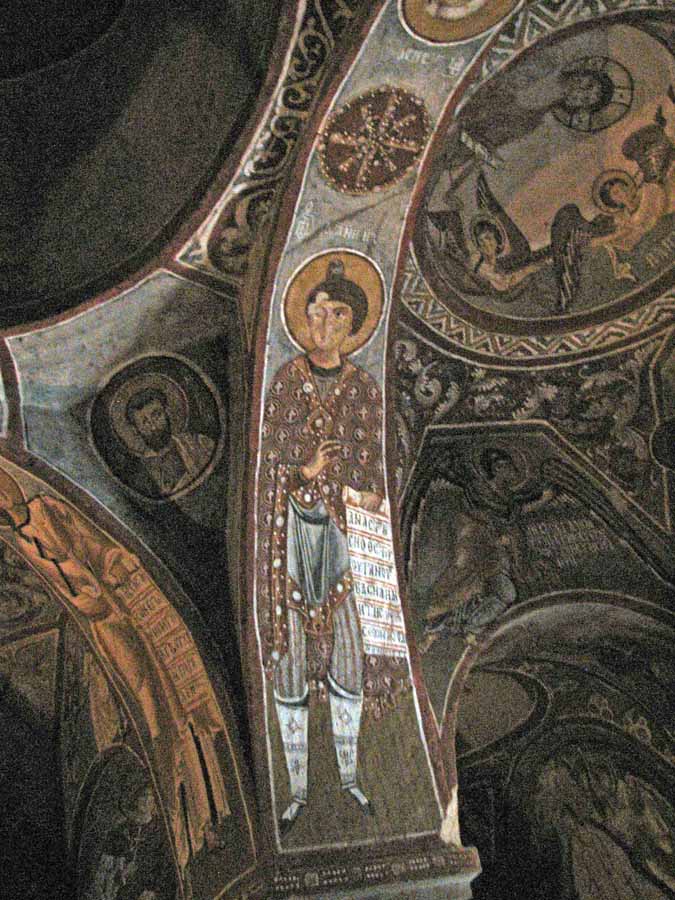
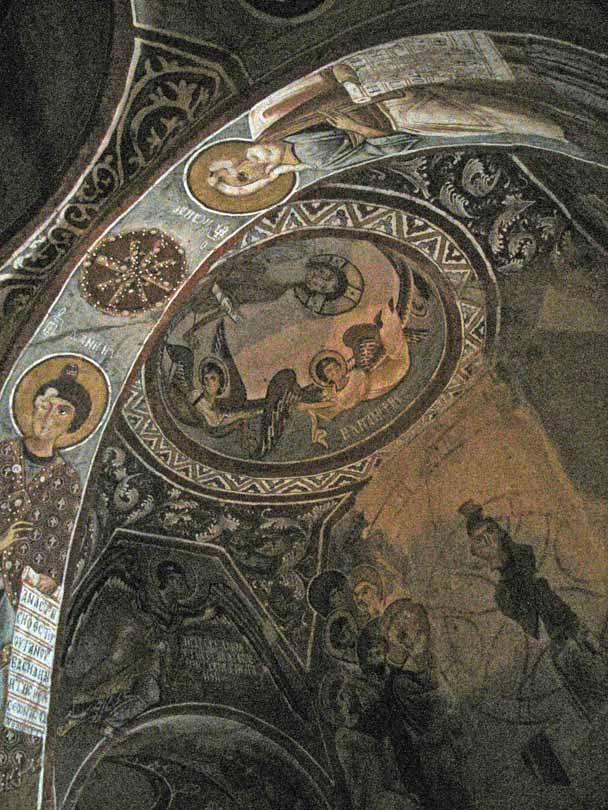

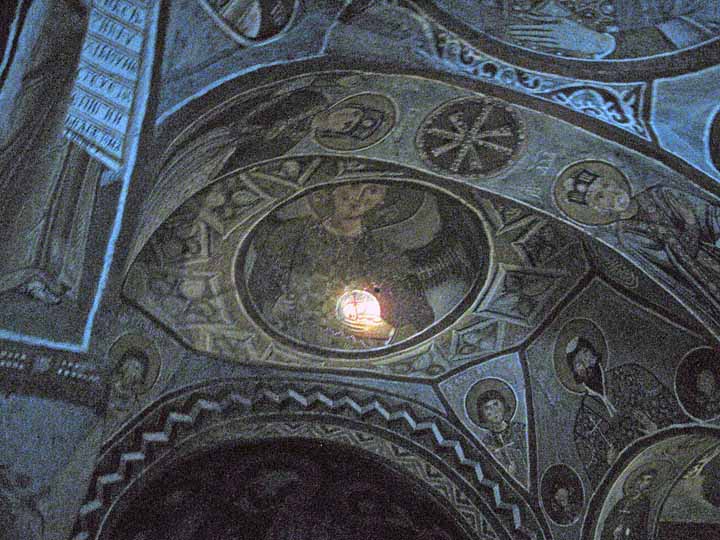 OK
- how does one explain the over-all darkness of the painting, with the one
bright spot just on halo encased cross? No, its not the flash.
Kind'a like a ghost picture.
OK
- how does one explain the over-all darkness of the painting, with the one
bright spot just on halo encased cross? No, its not the flash.
Kind'a like a ghost picture.
 Amazing
there's so little destruction or wear,
Amazing
there's so little destruction or wear,
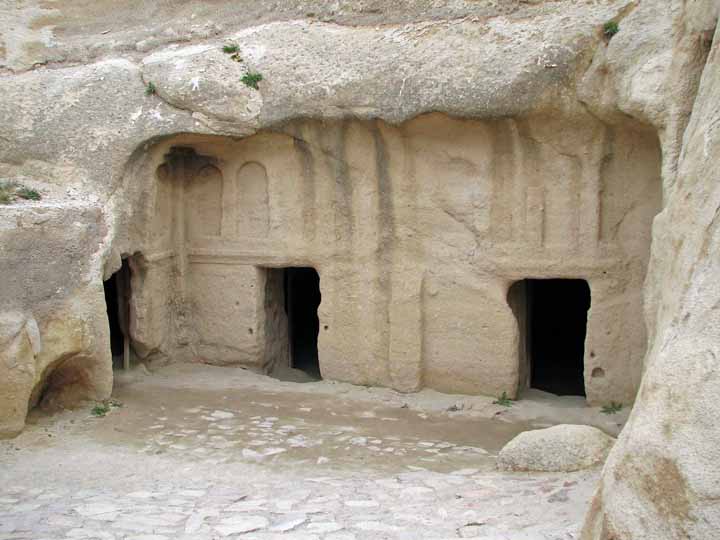
The color outside the church is natural
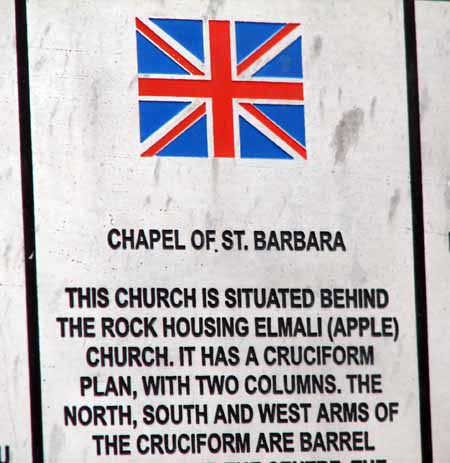
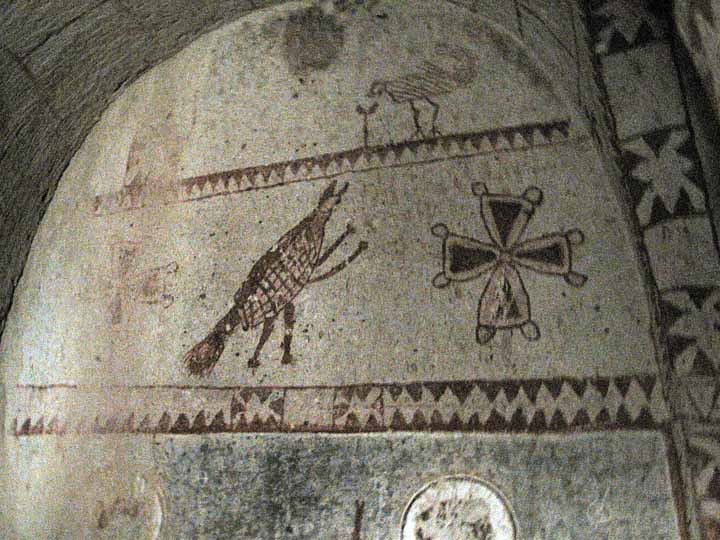 Some
of the paintings here remind me of paintings out west.
Some
of the paintings here remind me of paintings out west.
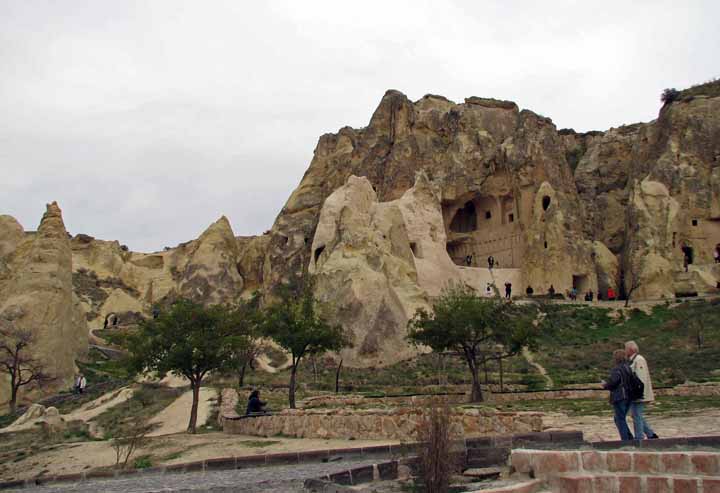
Looking across the area
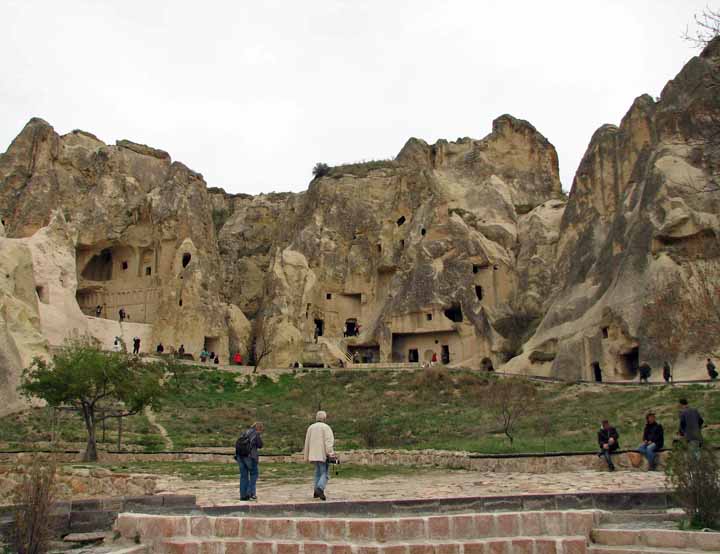

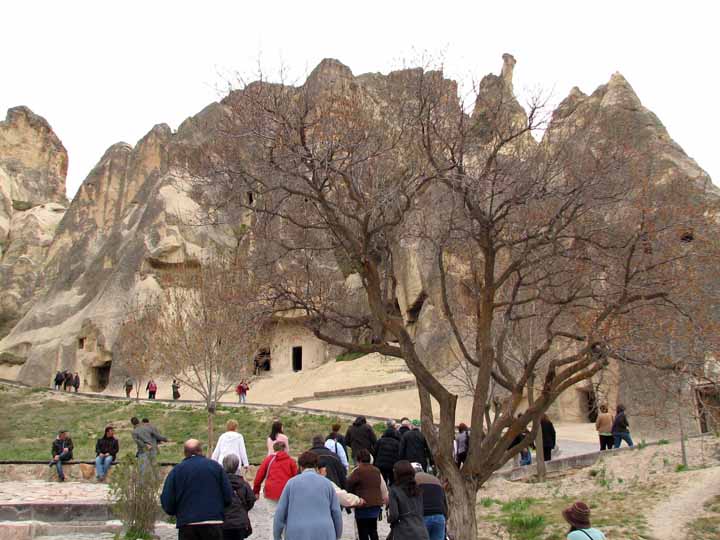

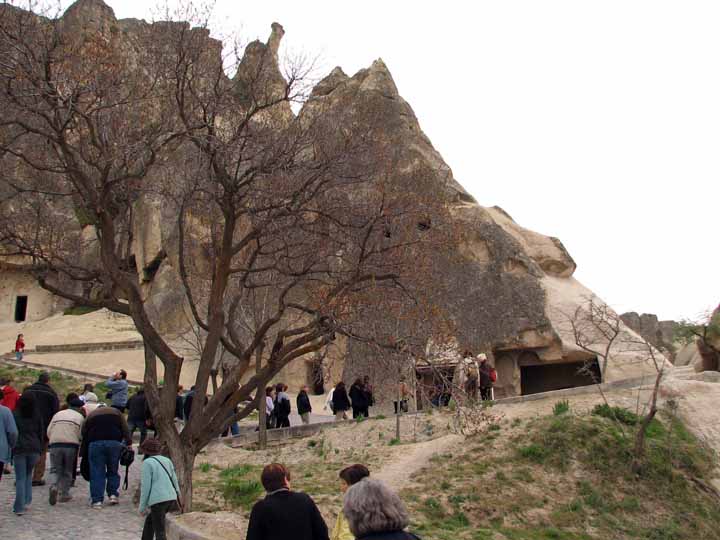 No
- we were not the only ones there visiting this site. However, it was rare
for us to be in a crowd, or being pushed and pulled by large groups anywhere we
went.
No
- we were not the only ones there visiting this site. However, it was rare
for us to be in a crowd, or being pushed and pulled by large groups anywhere we
went.

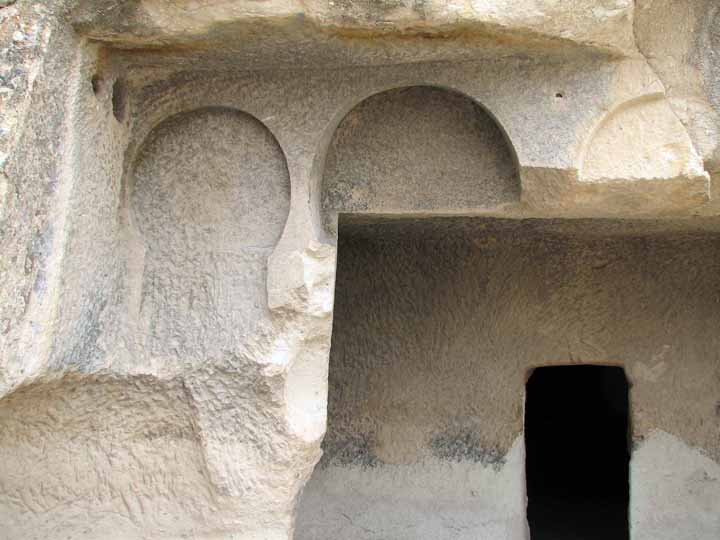
The front door does not prepare you for the finds inside
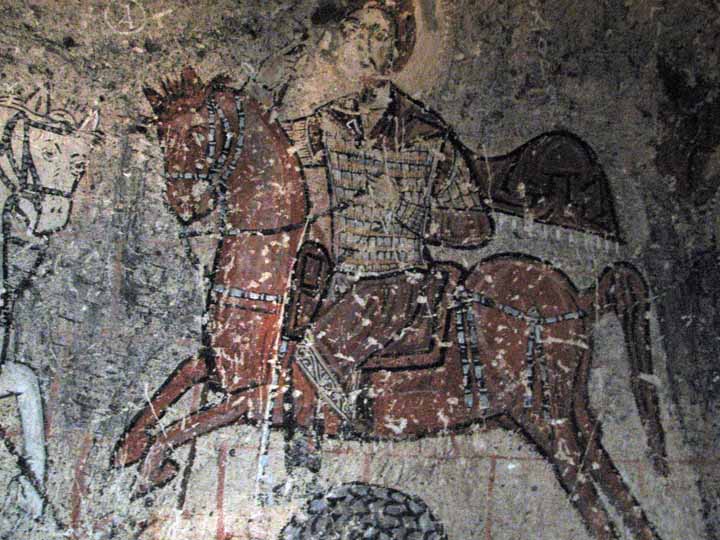 We
see St. Theodore - St George's companion
We
see St. Theodore - St George's companion
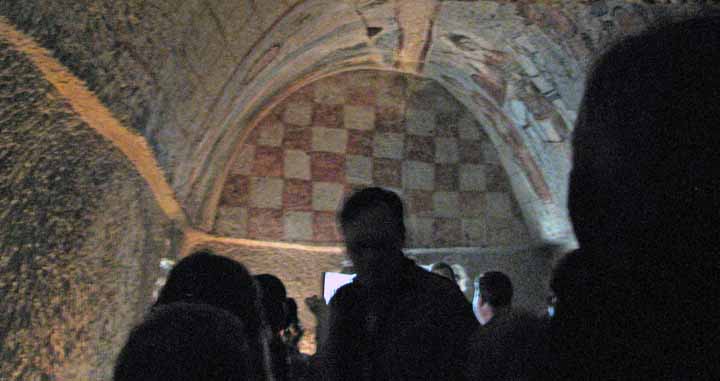
Unusual checker board patterns with excellent color
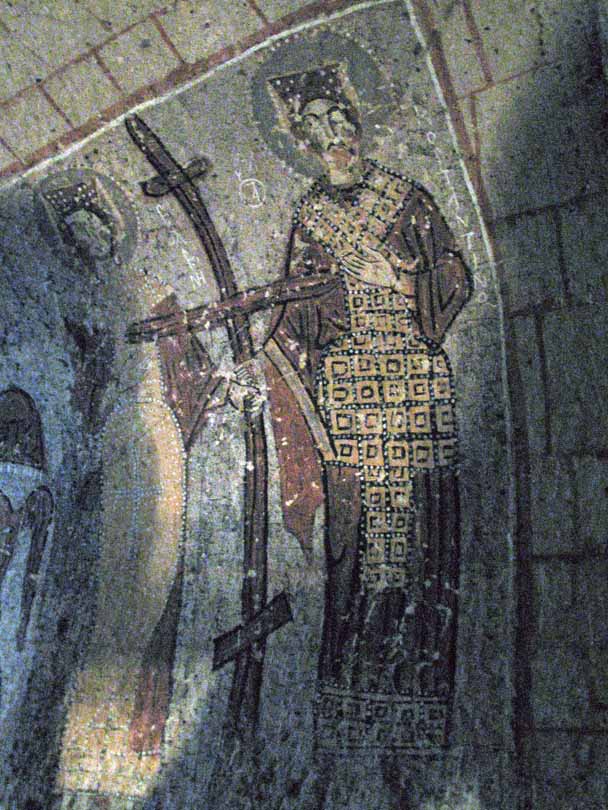
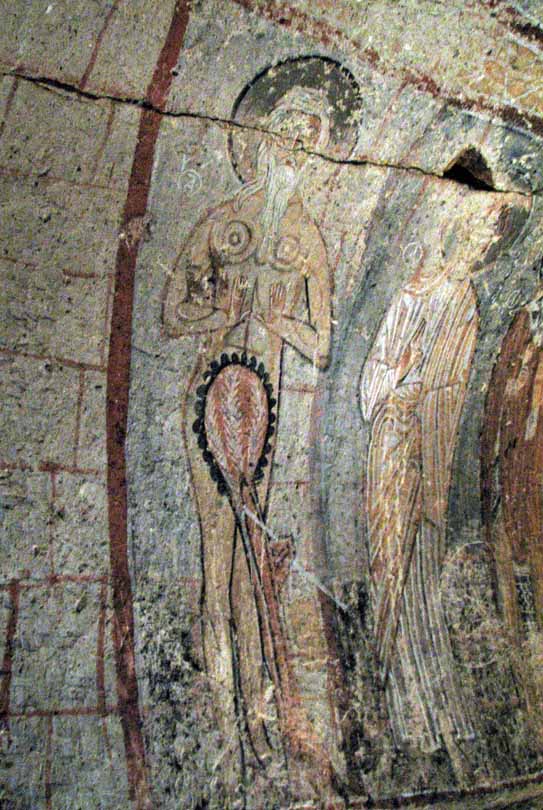 This
is the strangest of all the Saints portrayed in any of the churches. I've
spent time attempting to finds her name and have been unsuccessful. It is
said this figure was a female who was so beautiful that she distracted both
monks and men she was attempting to convert. She prayed to become less
attractive and God turned her into a male - with beard.
This
is the strangest of all the Saints portrayed in any of the churches. I've
spent time attempting to finds her name and have been unsuccessful. It is
said this figure was a female who was so beautiful that she distracted both
monks and men she was attempting to convert. She prayed to become less
attractive and God turned her into a male - with beard.
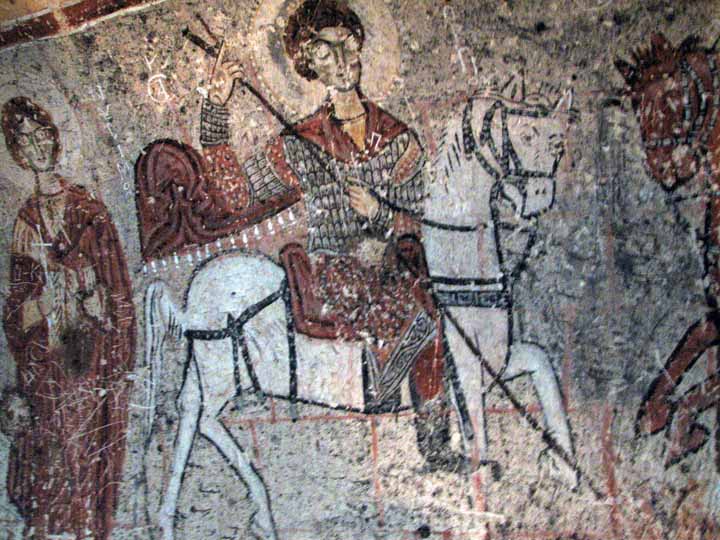
St George slaying the dragon. My patron Saint - I have collected icons of
St George where ever we visit.

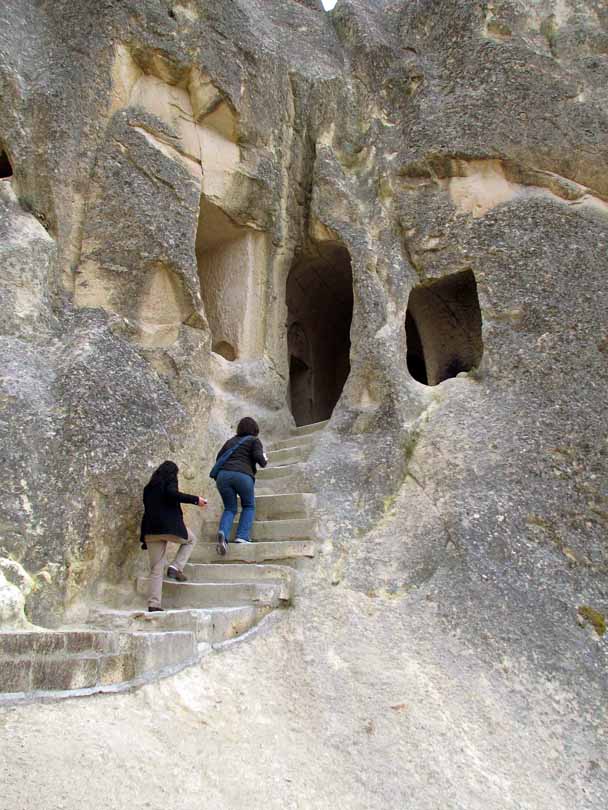 Climbing
the stair to other rooms
Climbing
the stair to other rooms
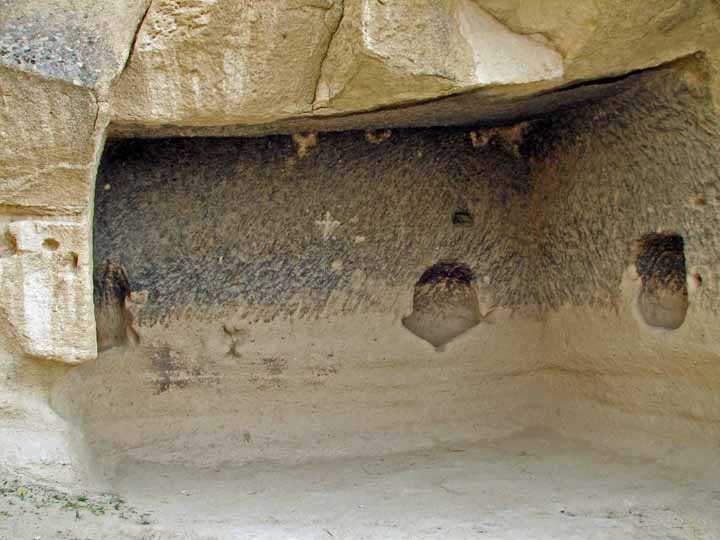
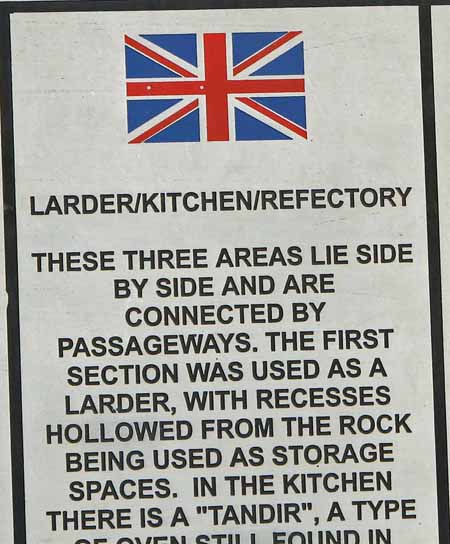
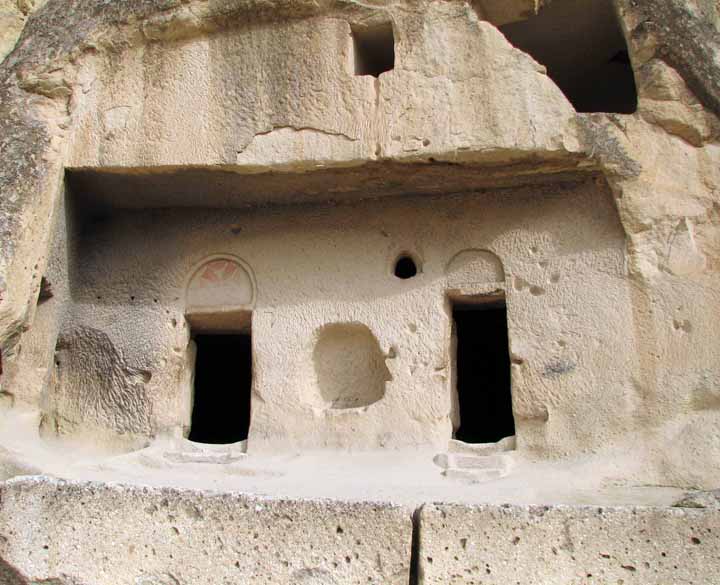
The entrances to the kitchen and dining area
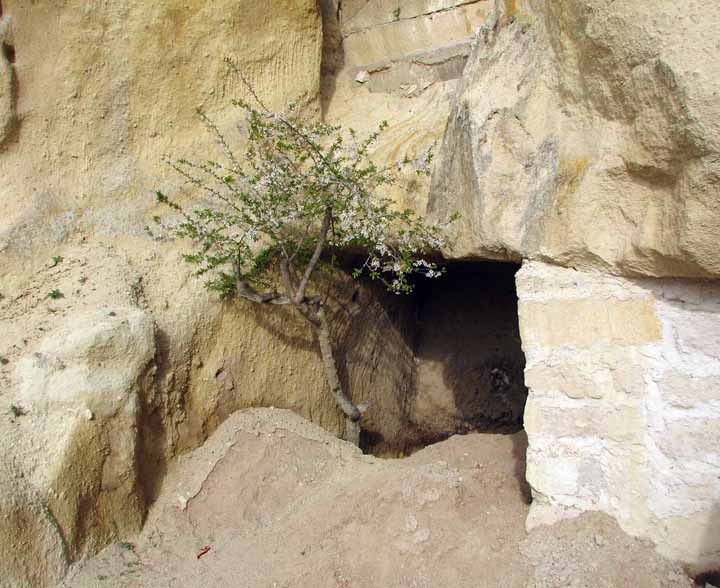 OK
- just a picture I liked as we climbed to the kitchen area
OK
- just a picture I liked as we climbed to the kitchen area
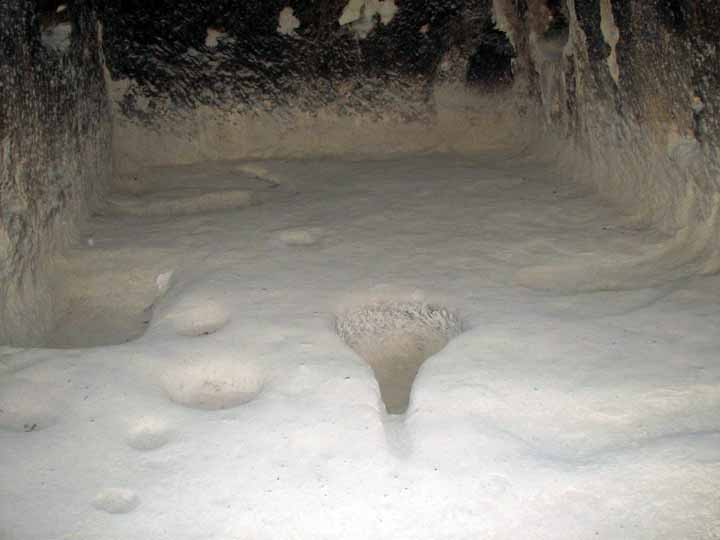
Cooking area - notice in the lower center, the place when grapes were crushed for the famous Cappadocia "Bulls Eye" wine, and the years of smoke that stained the ceiling and walls.
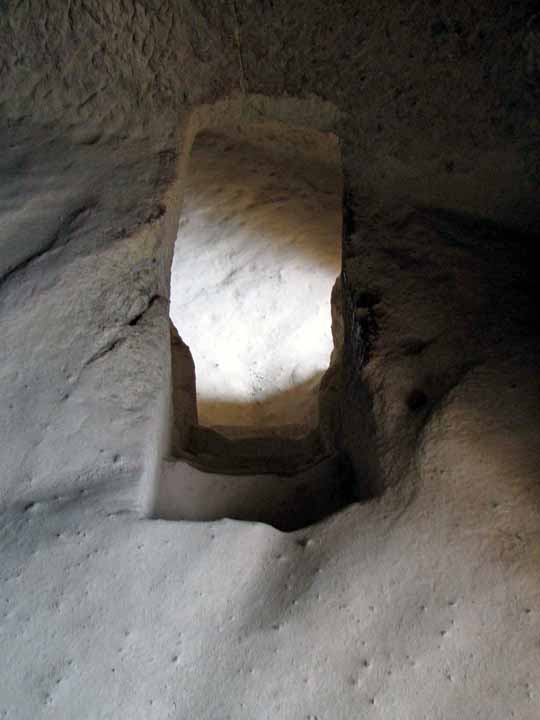 Passage between rooms
Passage between rooms
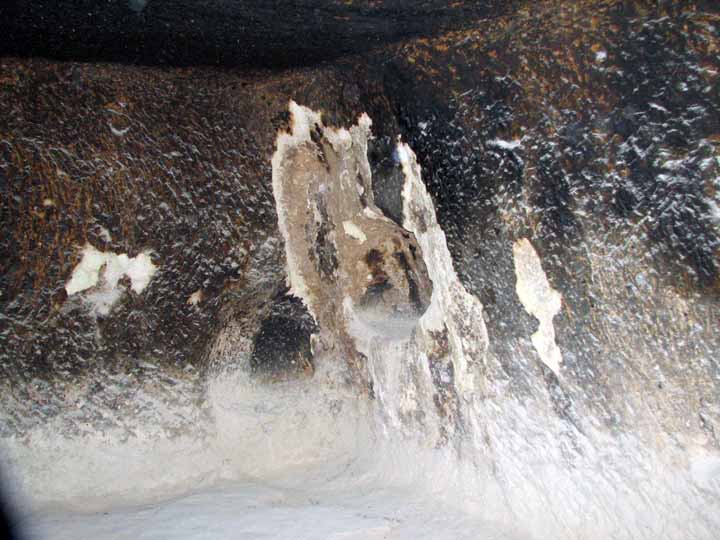
Dark smoke stains - how many years?
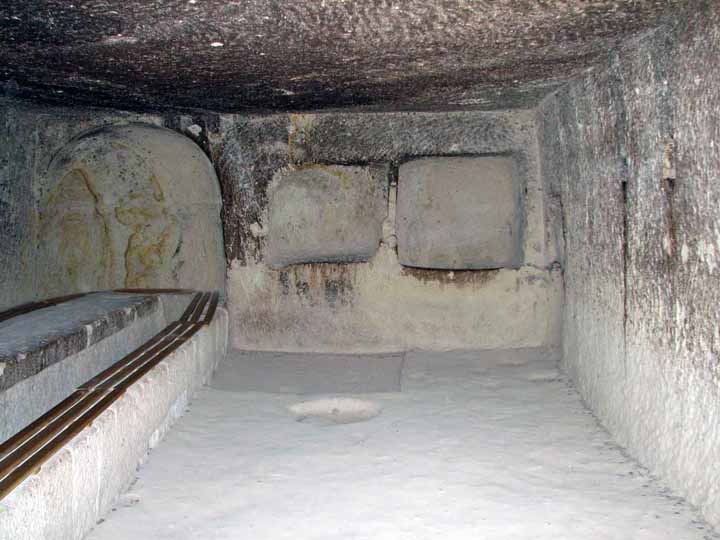 The dining area
The dining area
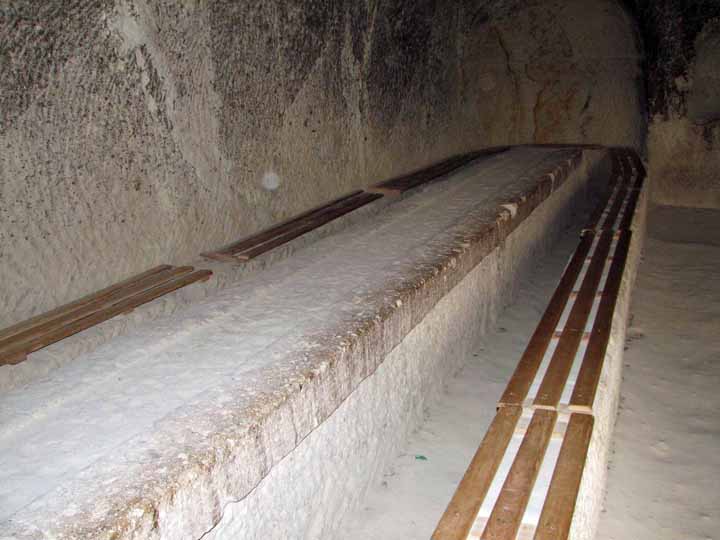
Benches surround the long stone table
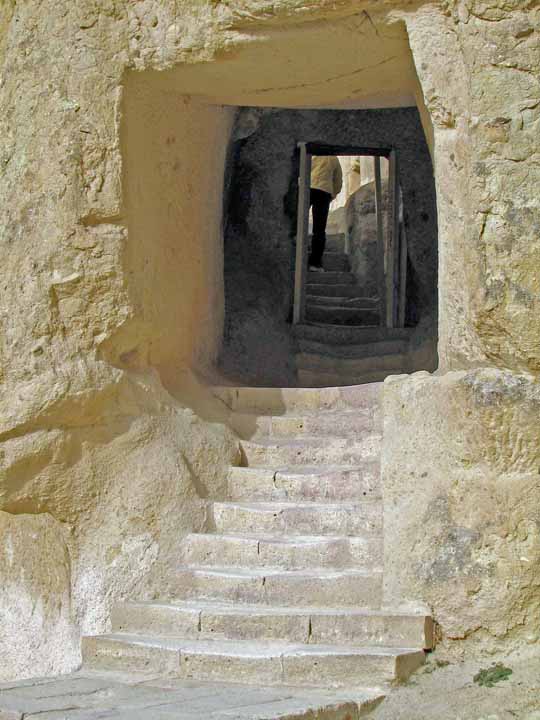 Hallway and stairs to another area. Most hallways, and particularly
doorways, are only large enough for one person to pass - a defensive tactic
Hallway and stairs to another area. Most hallways, and particularly
doorways, are only large enough for one person to pass - a defensive tactic
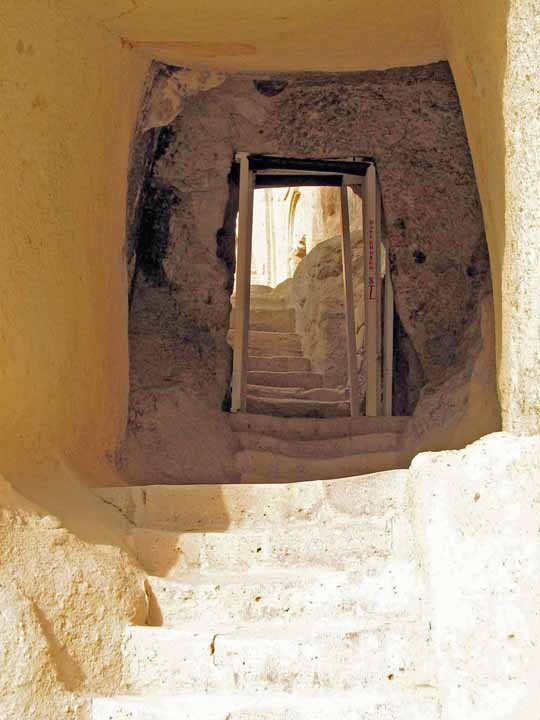
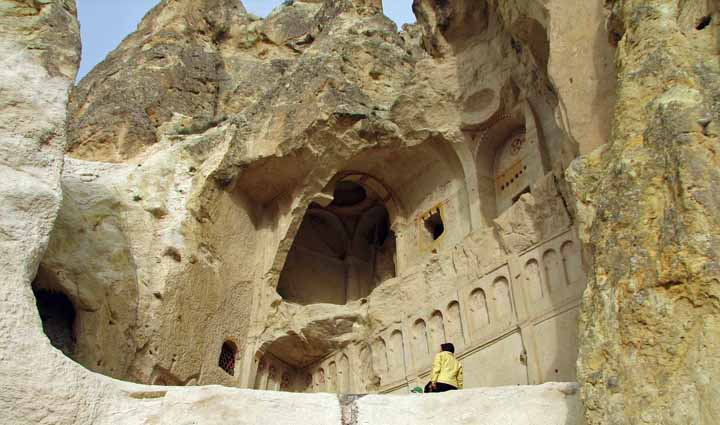
Look carefully for color and drawings everywhere.
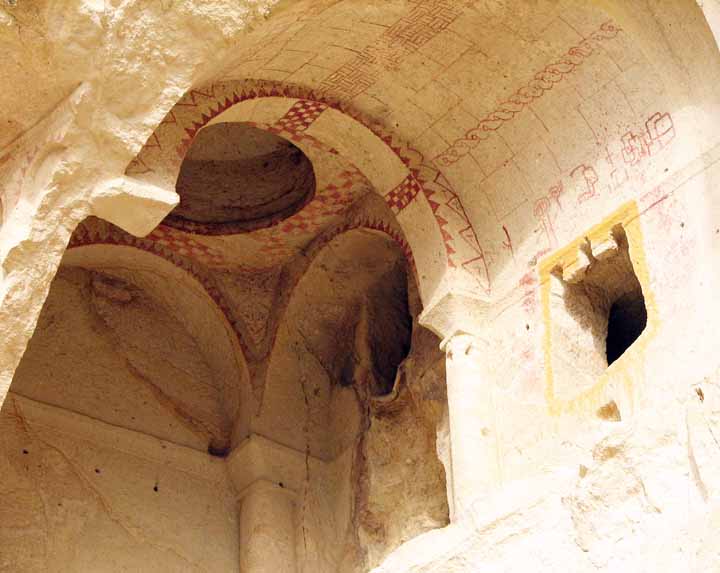 This
is a close up of the area pictured above.
This
is a close up of the area pictured above.
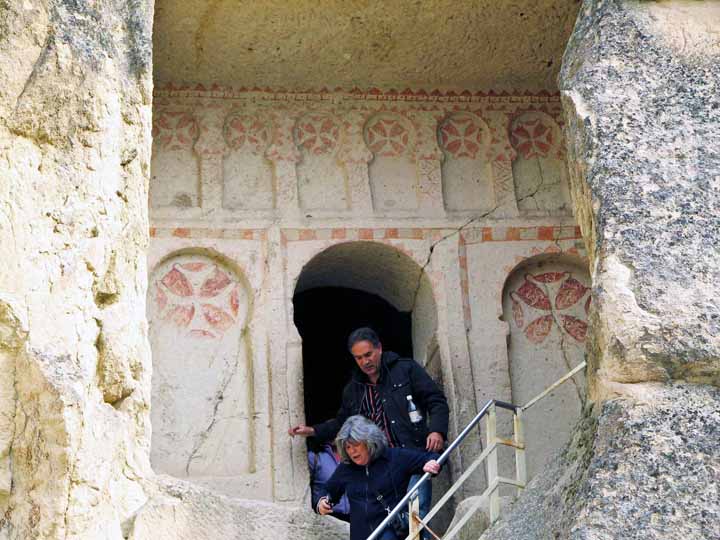
Stairs distract you from the decorations surrounding you


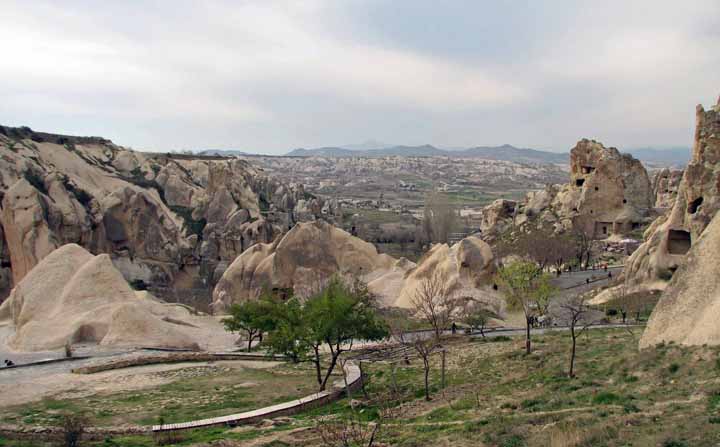

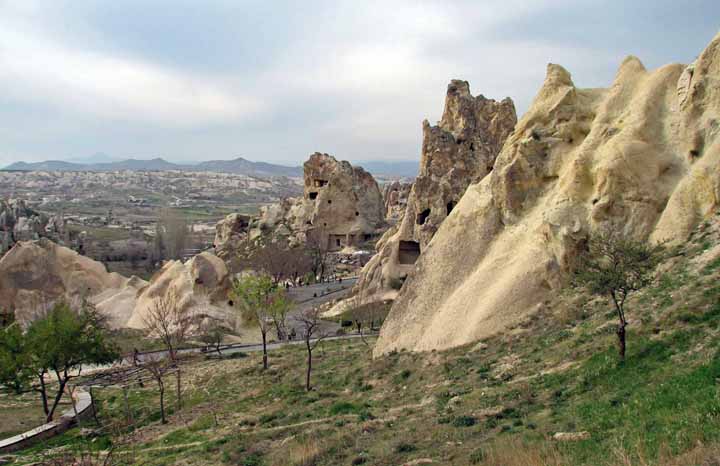
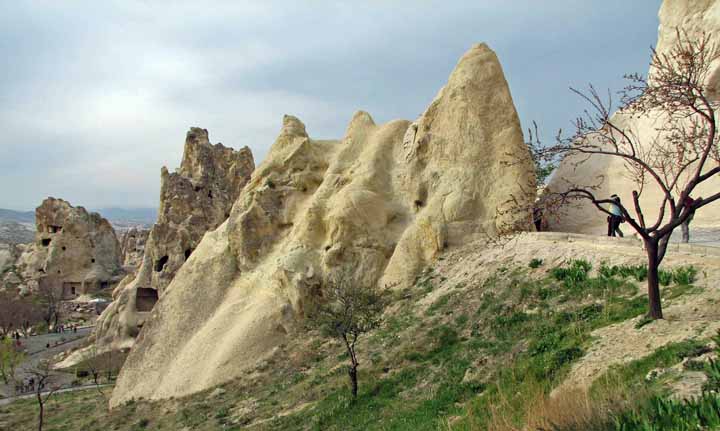

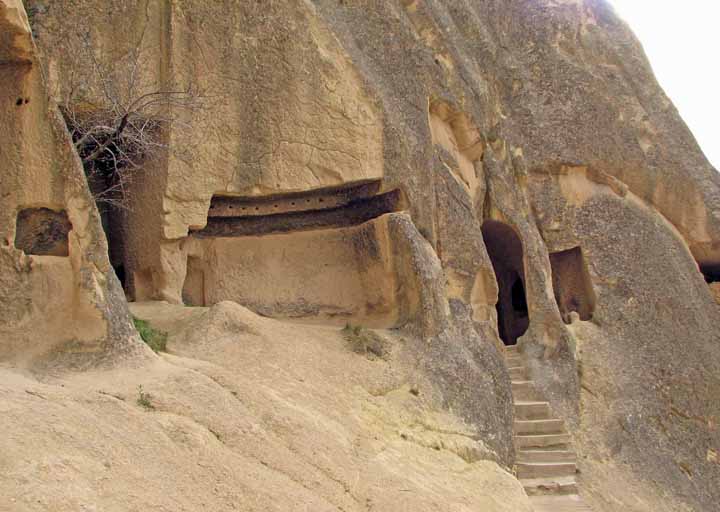
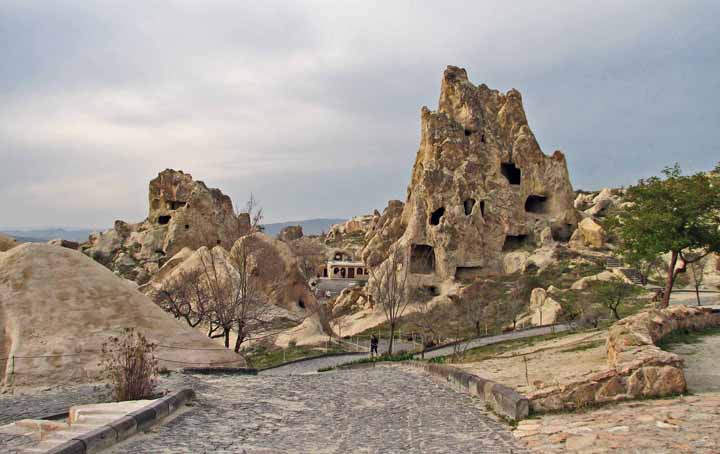
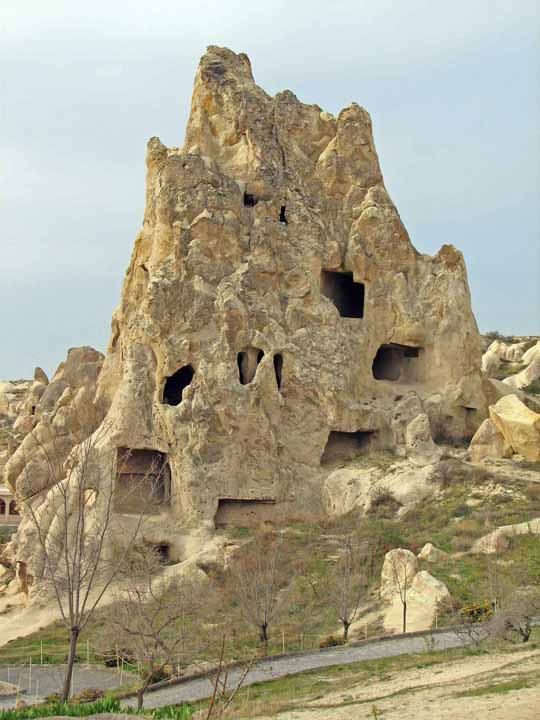
The Convent building to the left -
The building for the priests and monks below
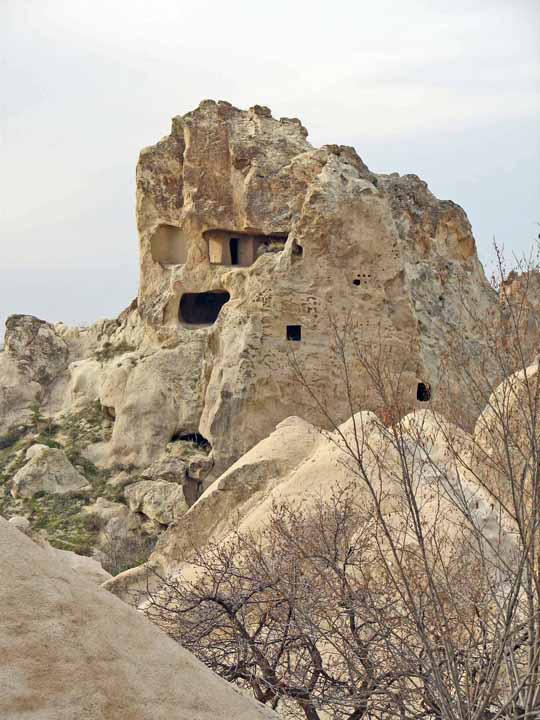
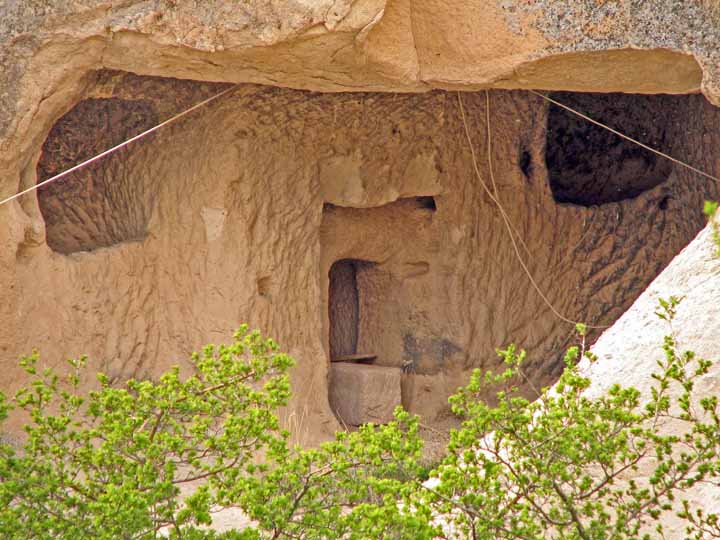
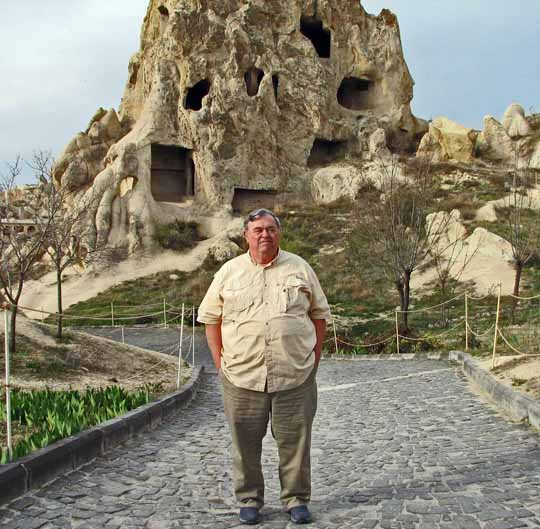

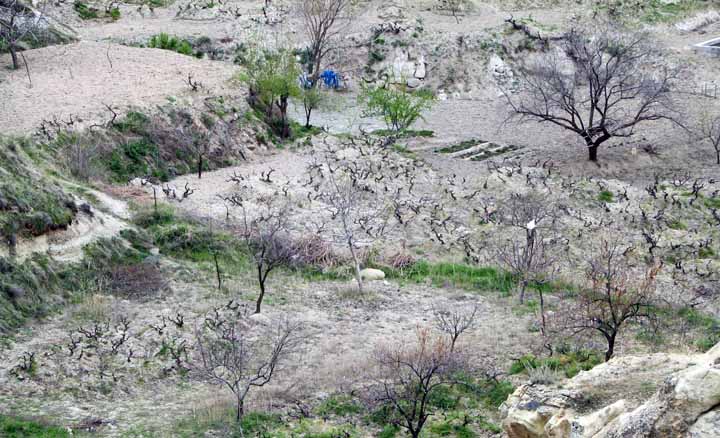
The famous grape vines of the Cappadocia Bull's Eye Wines. Notice the volcanic ash that passes for soil - they need large amounts of fertilizer (more to follow on that subject) Also notice that winter is just about over. The grape vines are trimmed and then buried during the winter to protect them. We have pictures of those still buried and some which owners have started to uncover


And Yes - people still live in these stone homes - way out from any town. If you look in the center / left of this shot you may see a bit of color beside a post in a cave.
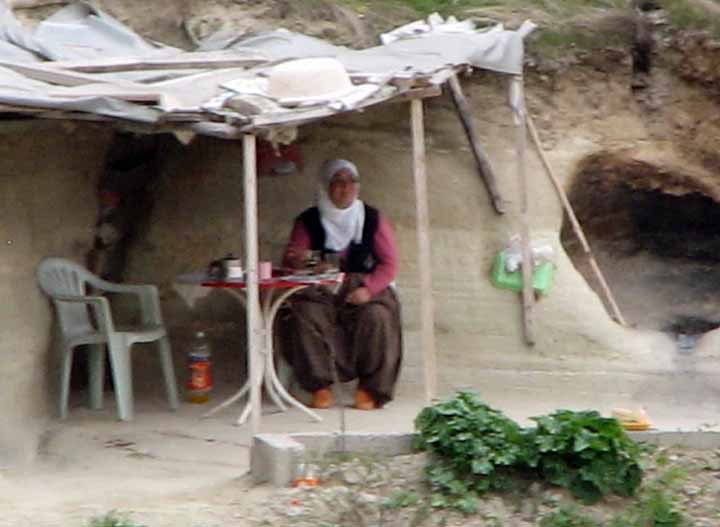 This
is that bit of color behind the post. She's taking a break. Notice the
place where they either cook or burn trash.
This
is that bit of color behind the post. She's taking a break. Notice the
place where they either cook or burn trash.
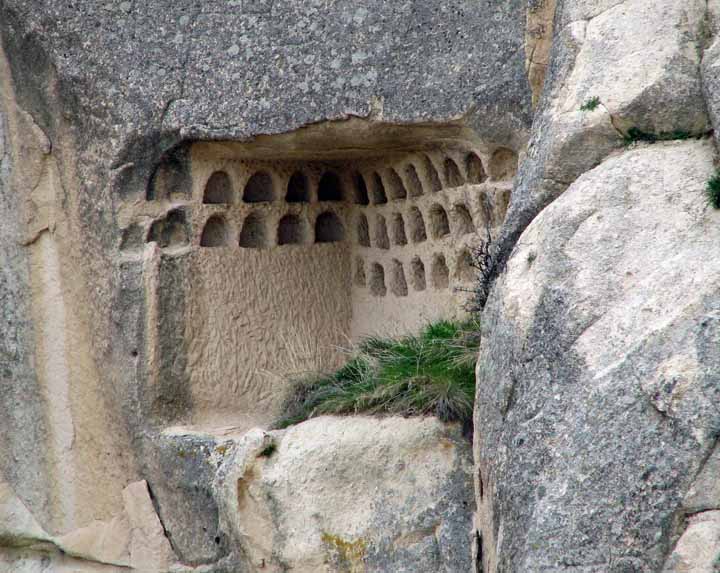 More
Post Office boxes?
More
Post Office boxes?

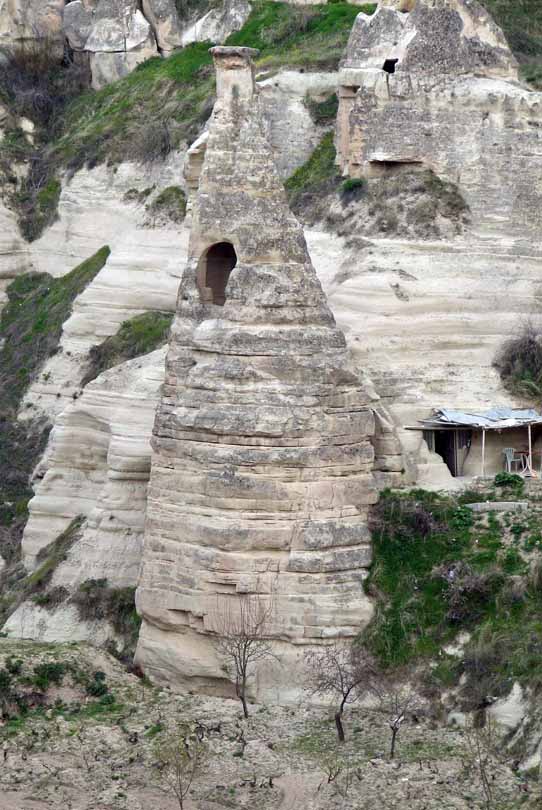 The
fairy tower next to the lady who was resting at the table.
The
fairy tower next to the lady who was resting at the table.
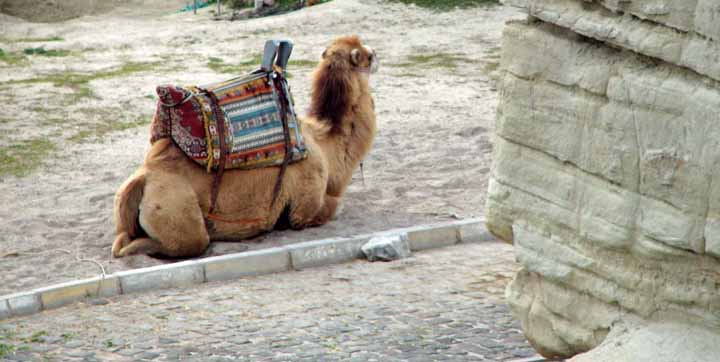
A camel waiting for tourists. No - the camels are not a regular part of the scene

Notice how this place has been made more livable - even a banister
 You need to look everywhere - there's color decorations hiding
high and low. Below see a close up of the red decorations at the top of
this structure.
Stunning!
You need to look everywhere - there's color decorations hiding
high and low. Below see a close up of the red decorations at the top of
this structure.
Stunning!
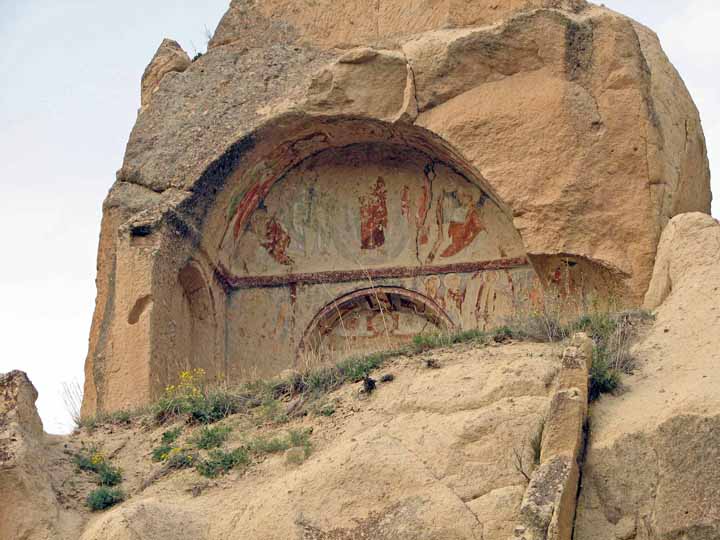
A person could spend years exploring just in this one area - one of the most popular for tourists. One must wonder what else there is in less accessible areas.
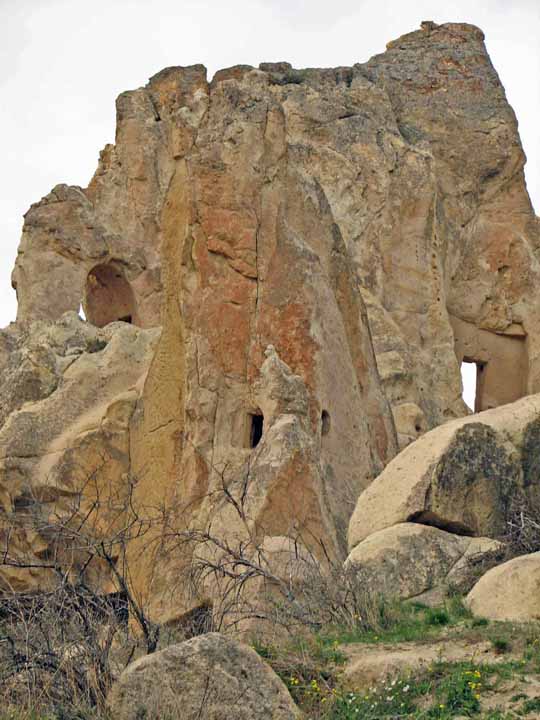
A nice one bedroom apartment? 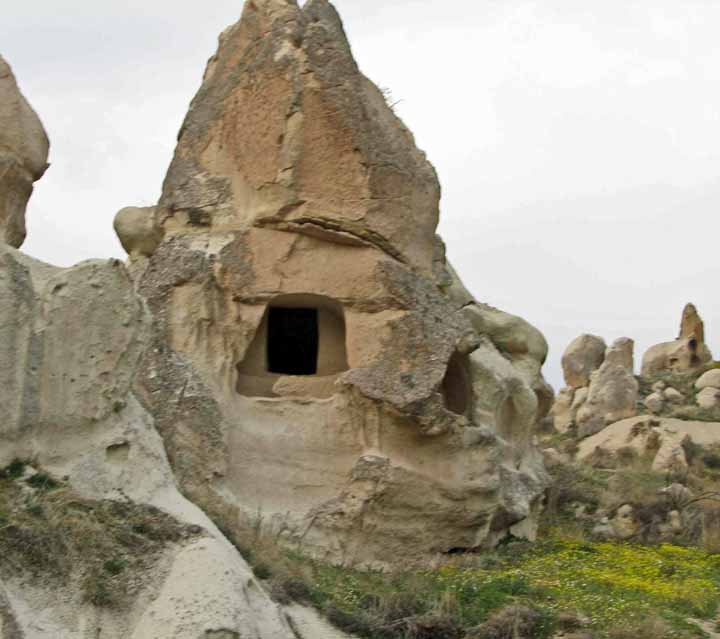
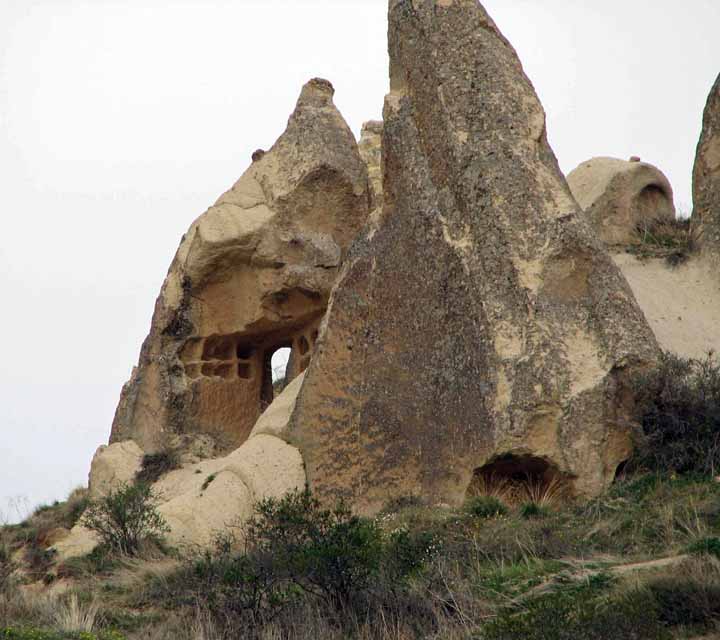
We leave this area to one which has "Top Hats"
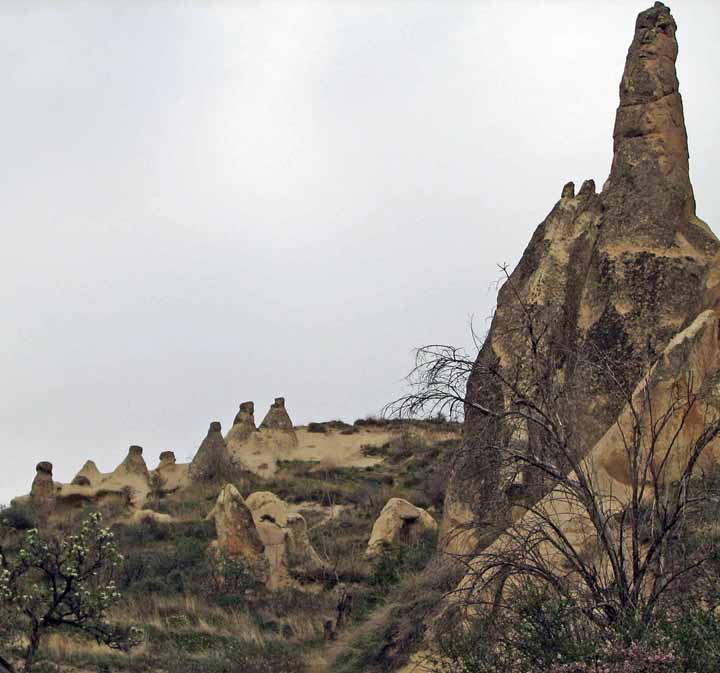
Oh - we see a balloon as it sails past
More on that later also

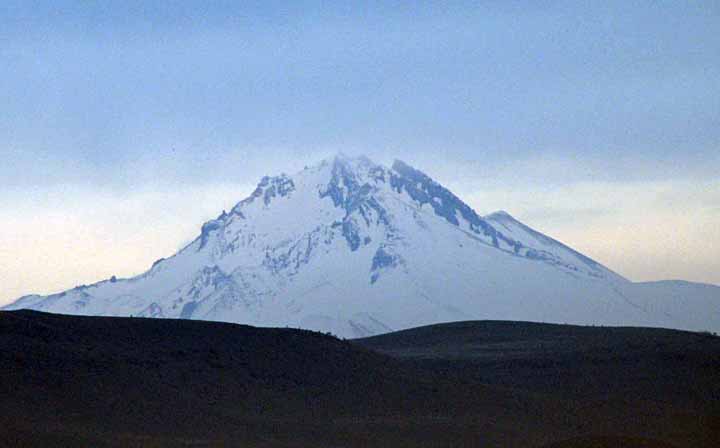
With the volcano in the background, we visit one of the more famous formations -
the Three Sisters
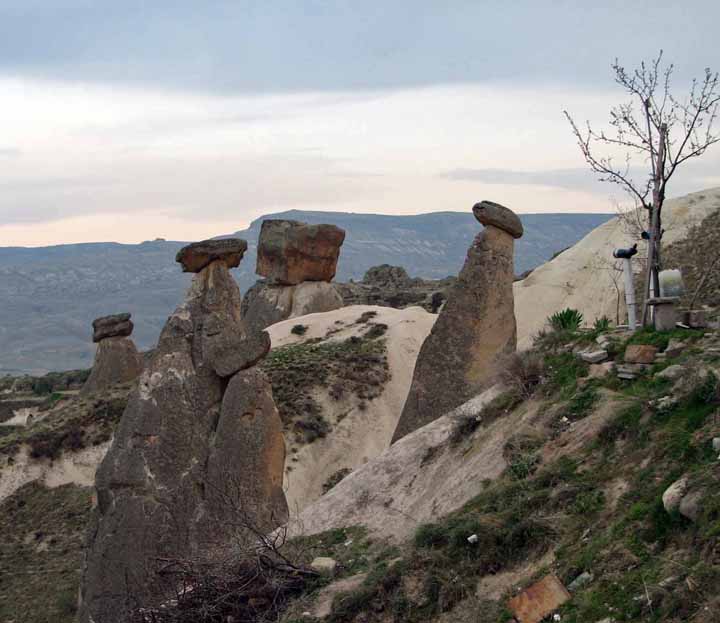
Ok, it looks like four - but one with the square "hat" is not a sister
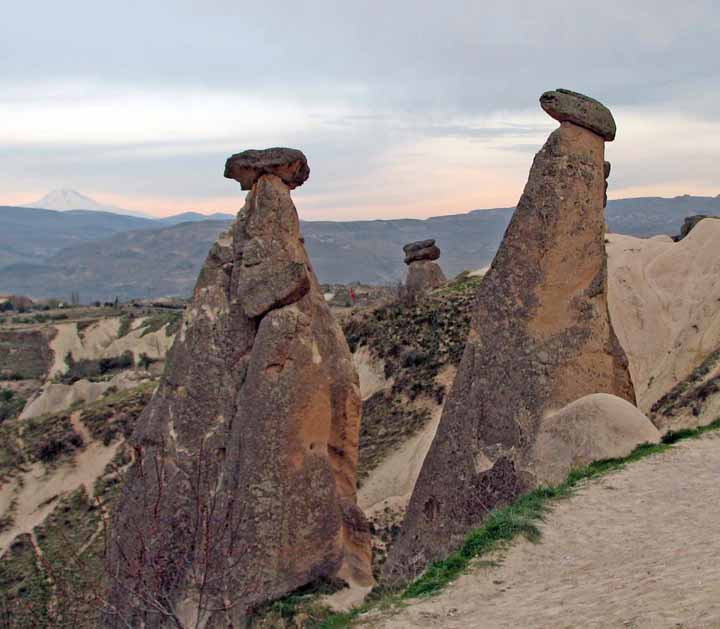
These are the Three Sisters
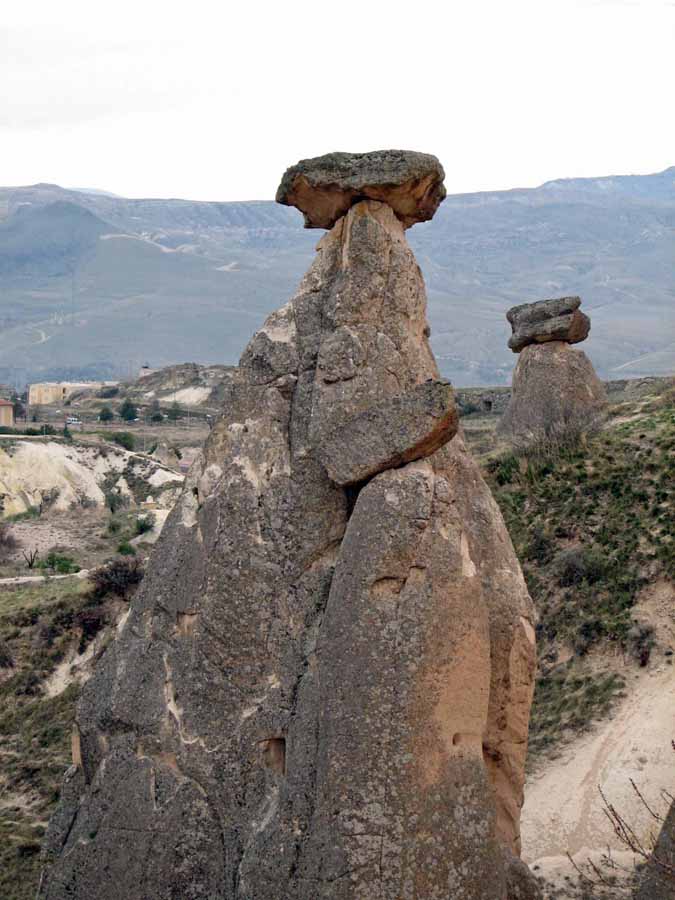 Sister
One and Three
Sister
One and Three
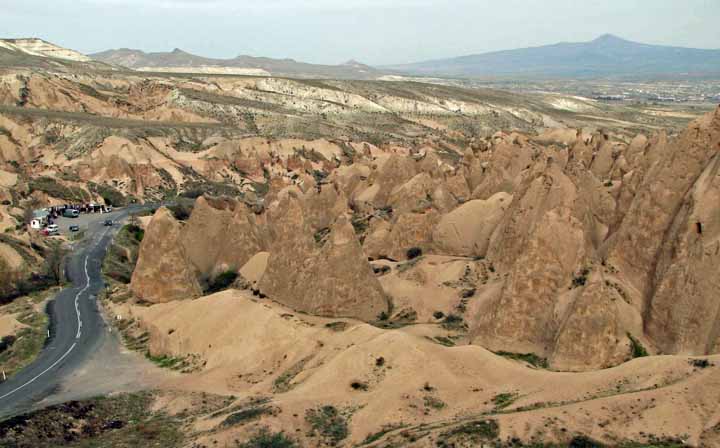
After the sisters, we're off to a new area. We were invited to get out for pictures and also choose to walk down to the next stop down below. Pictures - good, walk -not.
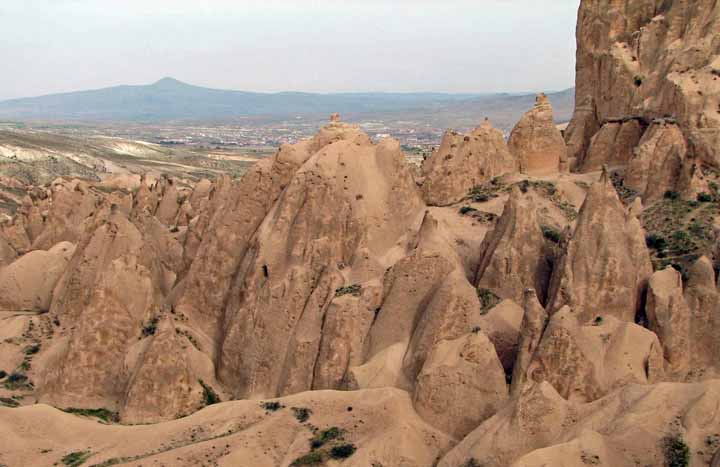
Notice another volcano on the left background.
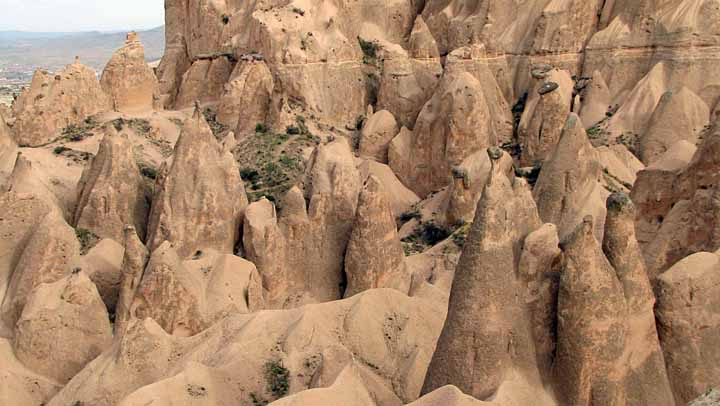
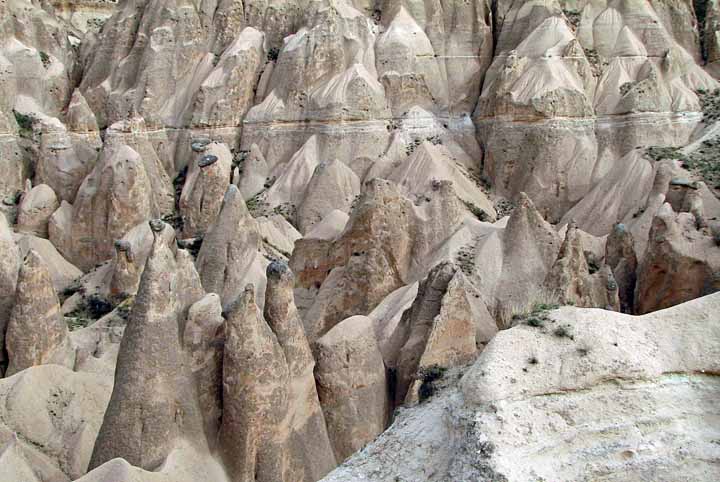
Notice we start seeing the "hats" on many of the fairy towers?
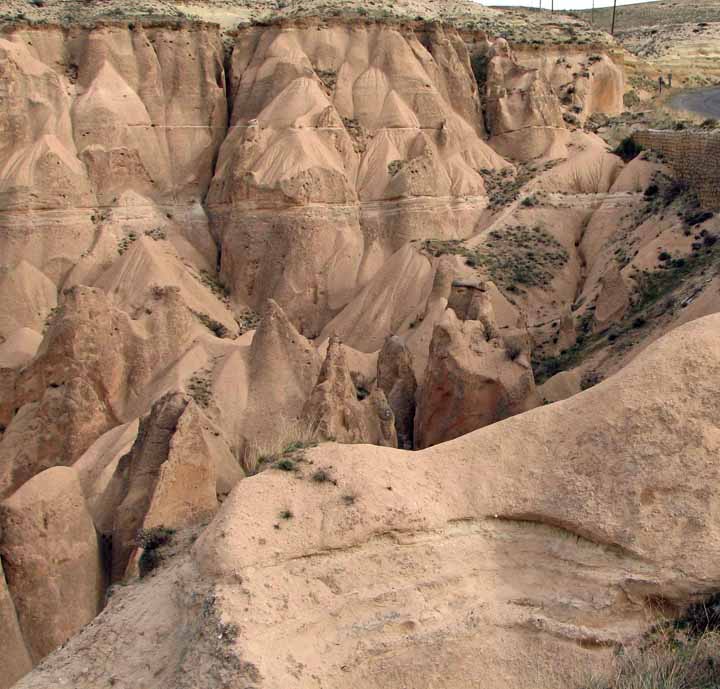
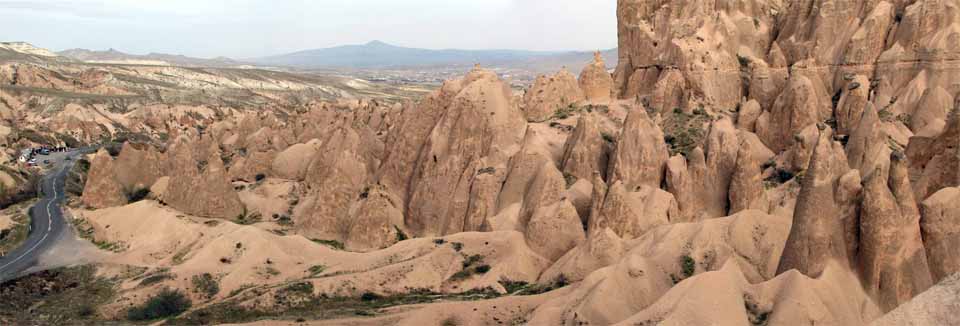
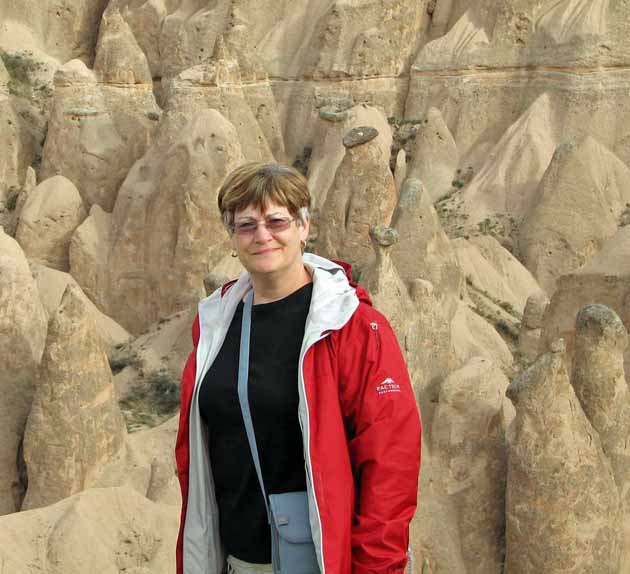 Jackie
- without a hat
Jackie
- without a hat
 These
fairy towers are just the place to allow your imagination to run wild.
These
fairy towers are just the place to allow your imagination to run wild.
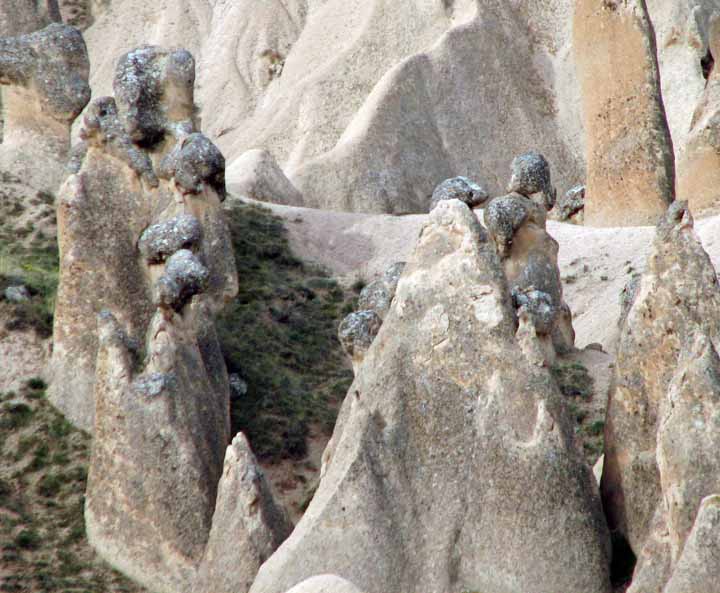

Layers of color surround us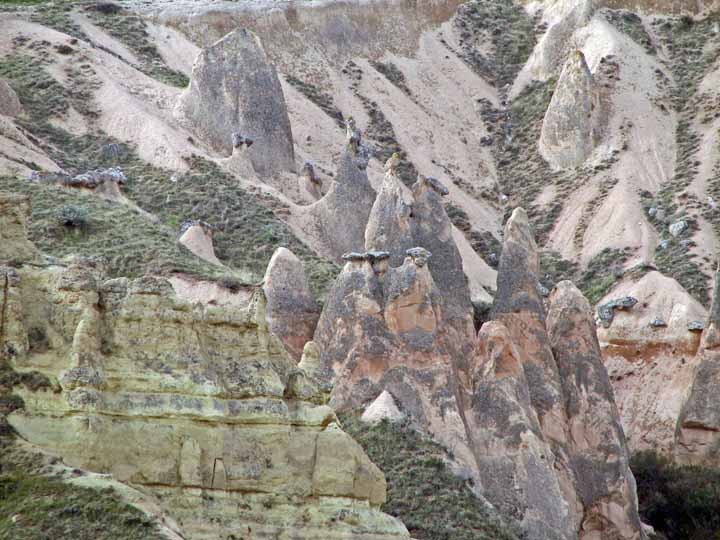

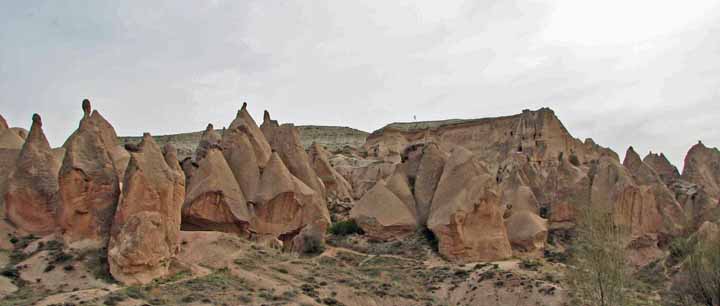

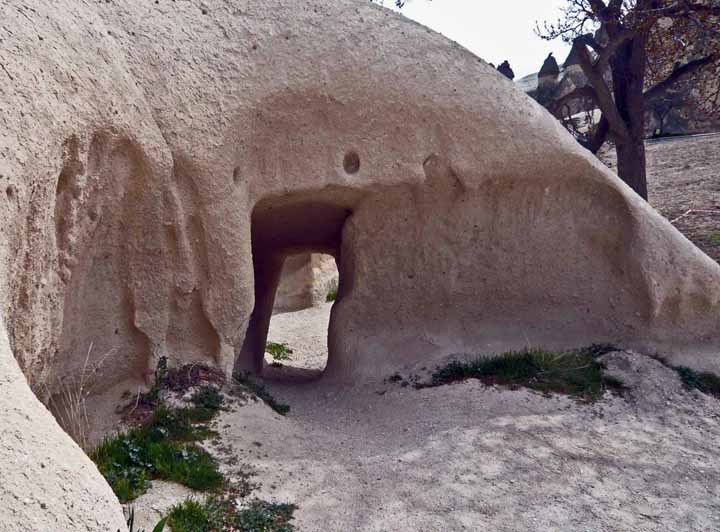

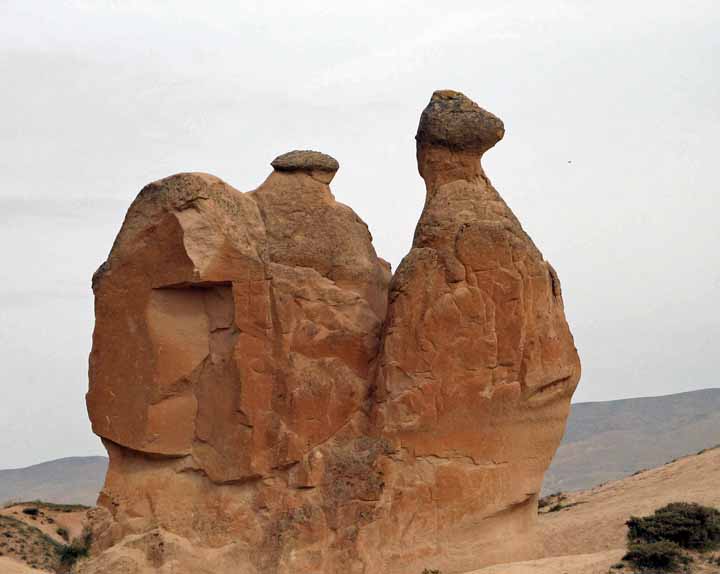
All right! I see a camel
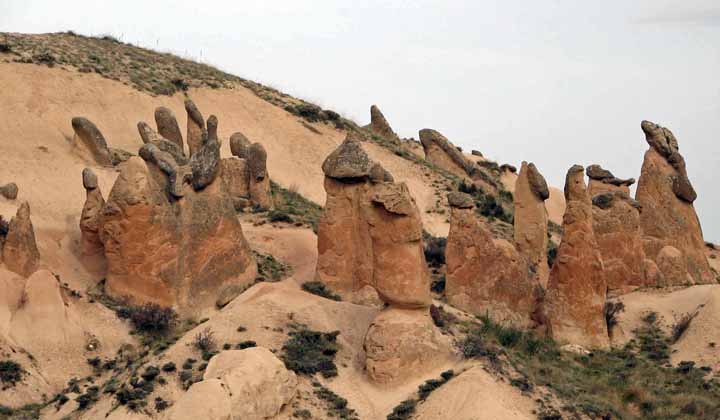
These remind me of some cartoon characters in Walt Disney's Fantasia. They had hats that covered their eyes, and although I can't remember the whole scene, I think they marched around in groups - like these above.

OK - what do you see? This is the Madonna
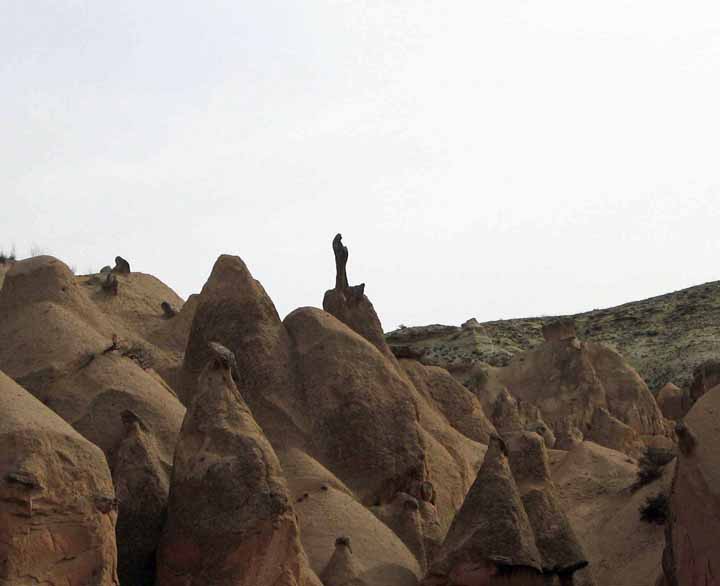
What is strange about Madonna is that, unlike most every visual based upon imagination, this one looks better - not worse - as you bring it into greater photo magnification

At 24 x, Madonna does not lose definition, but gains a sheep! Wild!
 As
we leave this area we are again surrounded by layer of colored lava.
As
we leave this area we are again surrounded by layer of colored lava.


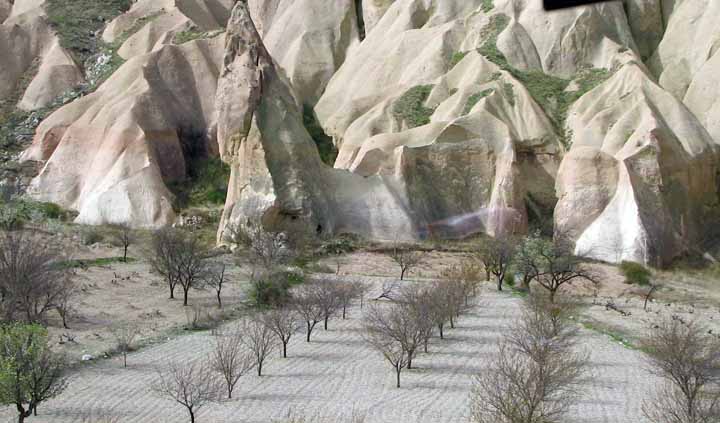
The well kept orchard - looks like green trees in the snow

A grave yard in the middle of the rocky field


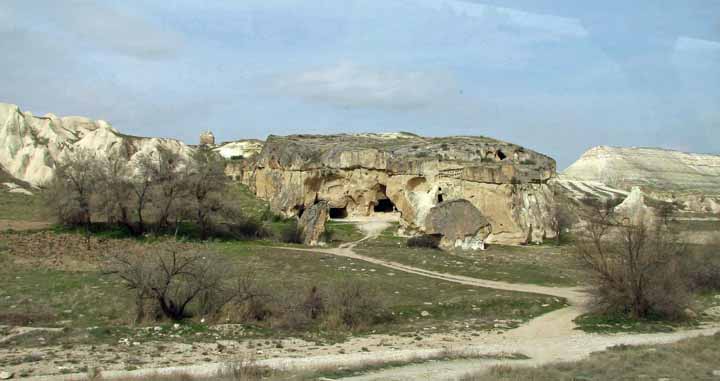
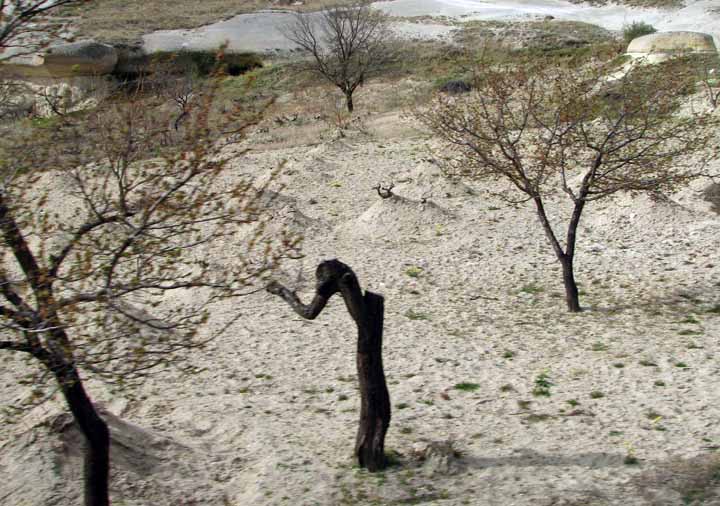
Notice the buried grape vines
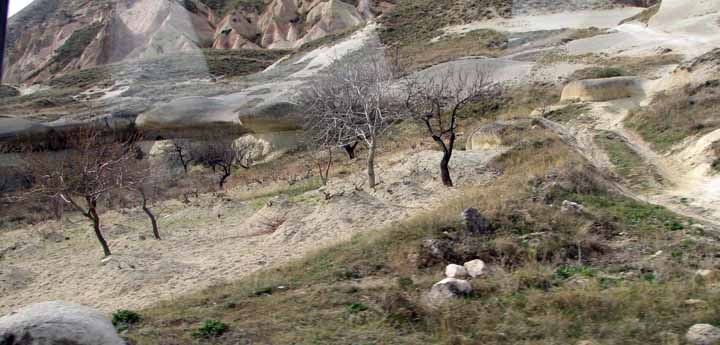
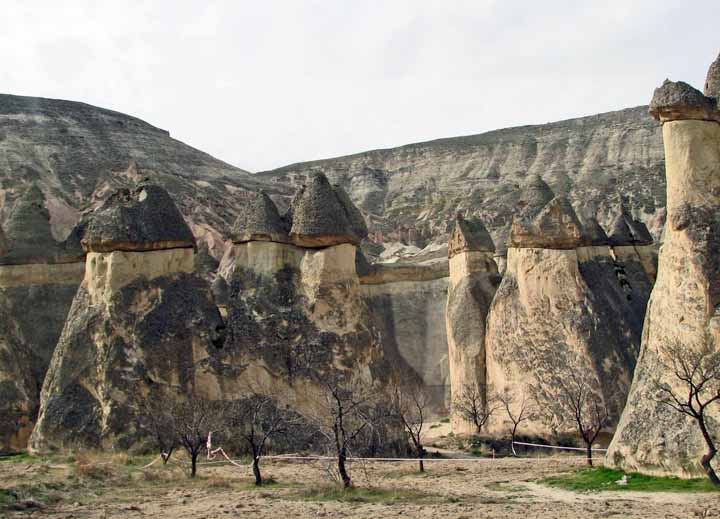
Huge fairy towers with the largest caps we've seen. The caps are more dense, harder ash, and as the softer ash is worn away, the harder ash is left balanced on the top, like a cap.

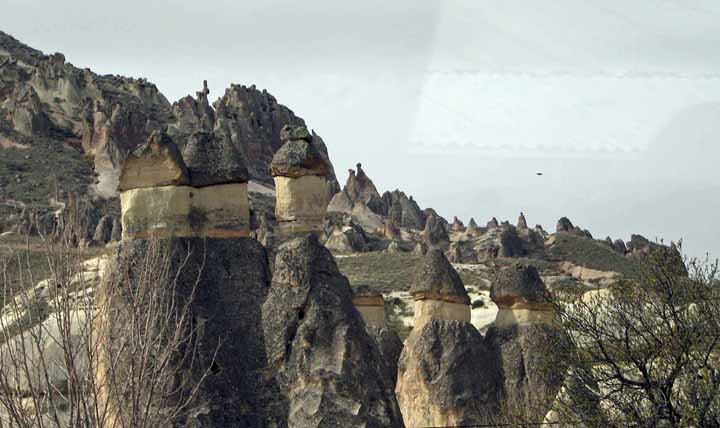
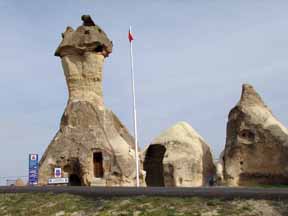
As our guide said - this is the most unusual Police Station you will lever see.
The station is is the tall structure. To its right is "office space" and further right is a small jail.
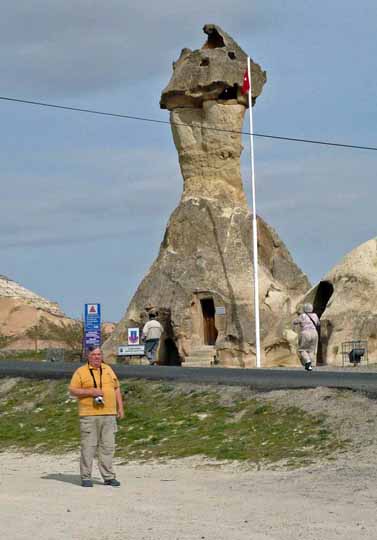
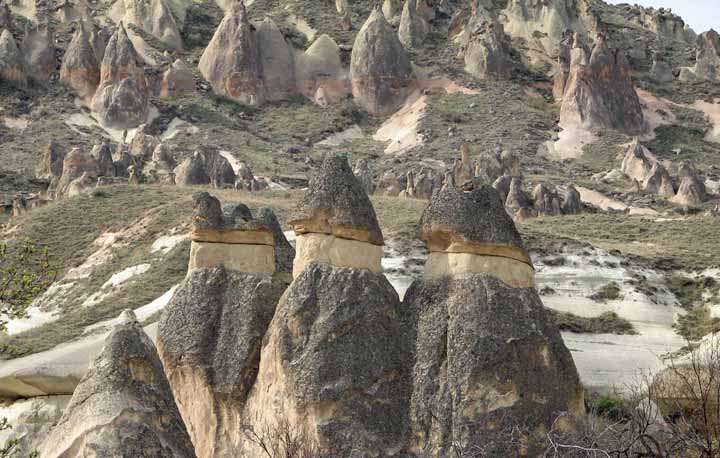
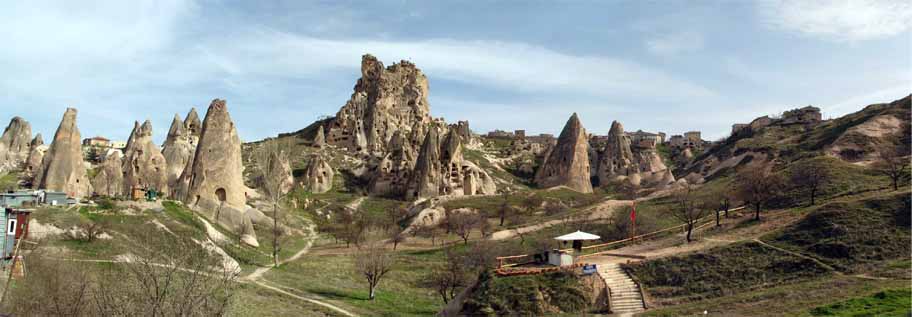
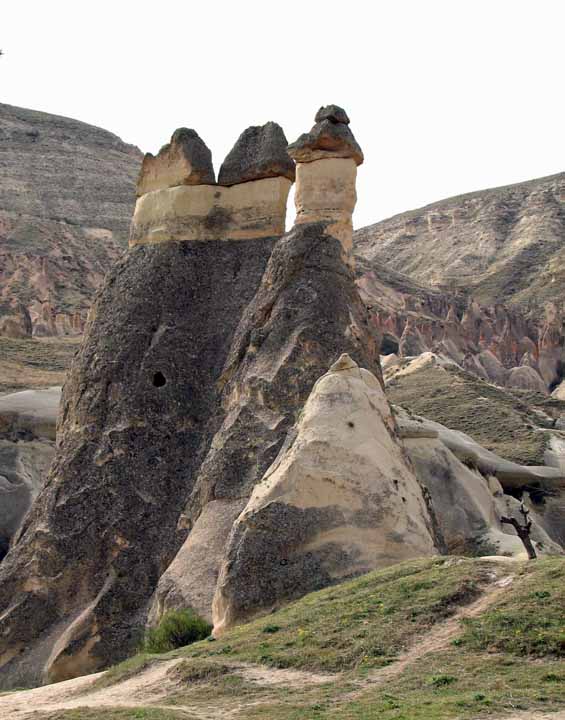

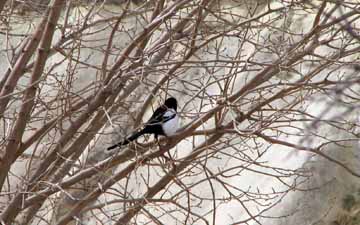 Can't
resist animals - strange , we saw few other birds than pigeons. Later
we find out more about all the pigeons.
Can't
resist animals - strange , we saw few other birds than pigeons. Later
we find out more about all the pigeons.
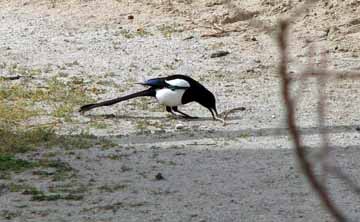
The bird was building a nest. We watched for some time as he/she flew back and forth.
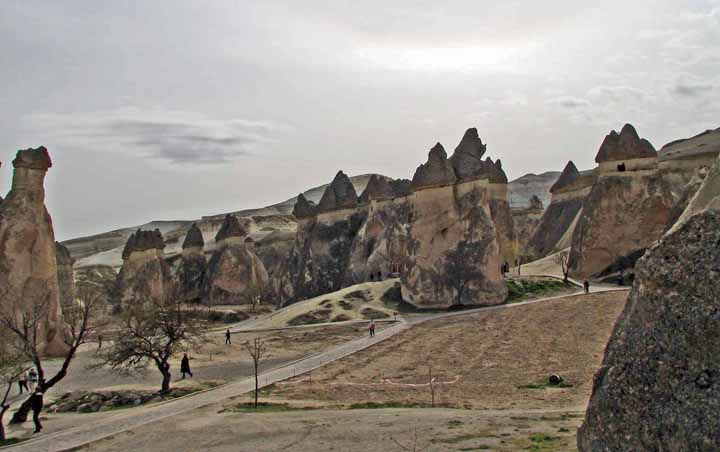
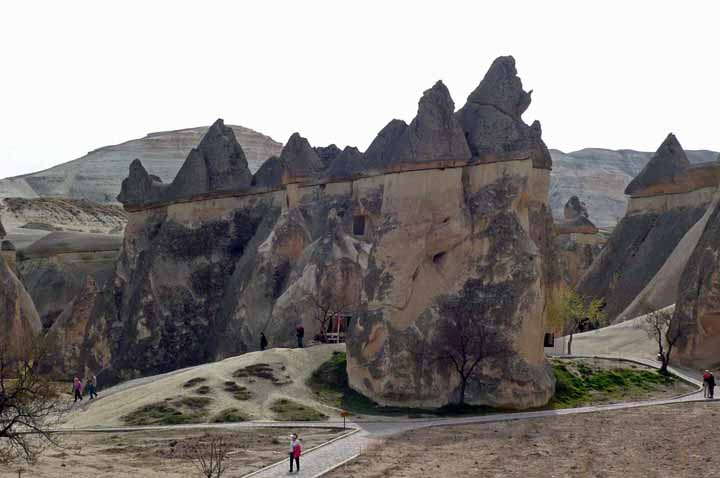
We stopped here awhile. I made a terrible attempt to show how tall and steep these towers were from down below - as you can see, I blew it!
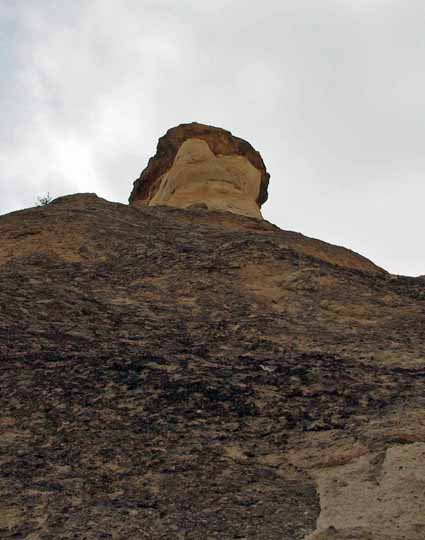
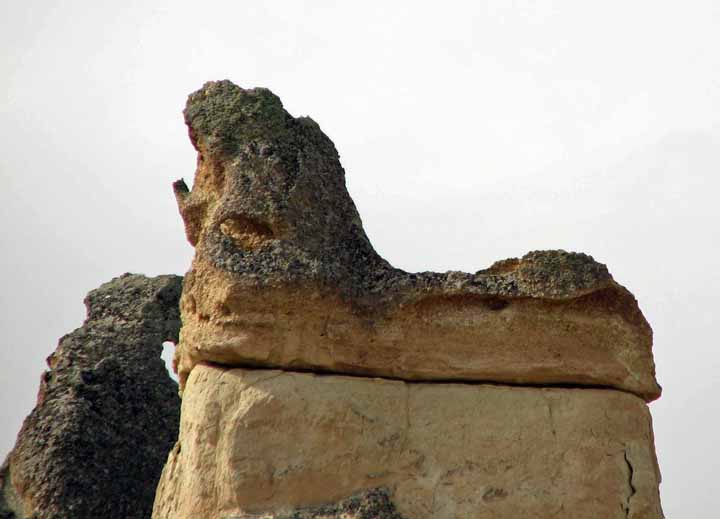 I
don't care what you say - this is my lion - OR - maybe its my walrus - or its my
beach master..........
I
don't care what you say - this is my lion - OR - maybe its my walrus - or its my
beach master..........
 See my sparrow?
See my sparrow?
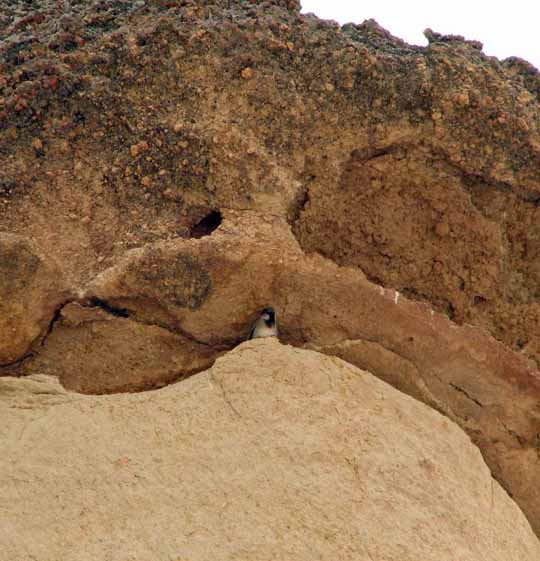
How about now?

And now?
While many in the group walked in one direction, Jackie and I walked in another, to a tower that kind'a stood alone. In it (as seen from the outside) we saw some really neat things.
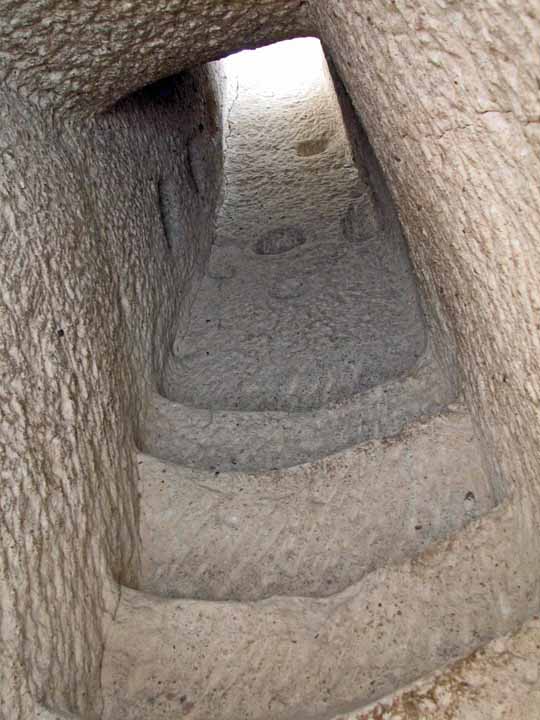
Like these stairs - no optical illusion - they are going up. First some steps, the hand-holds and dug outs where to place your feet.
 Another view
Another view
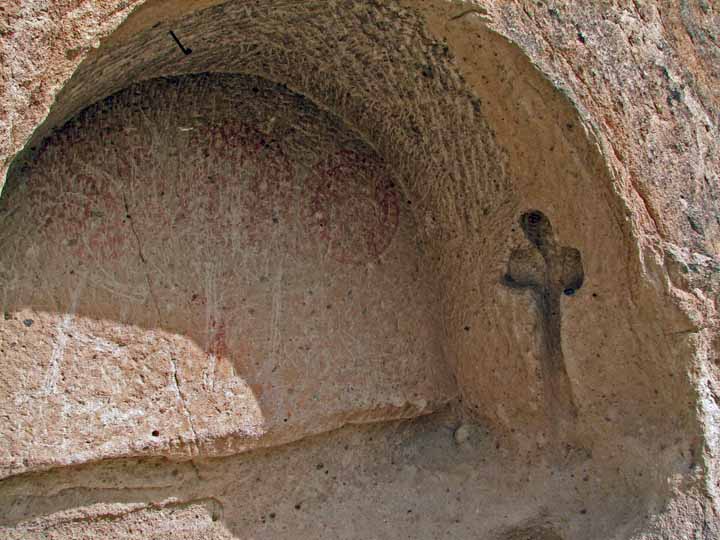
This area, with the faded red decorations, was maybe 40 feet up the side
of the tower, with no entrance
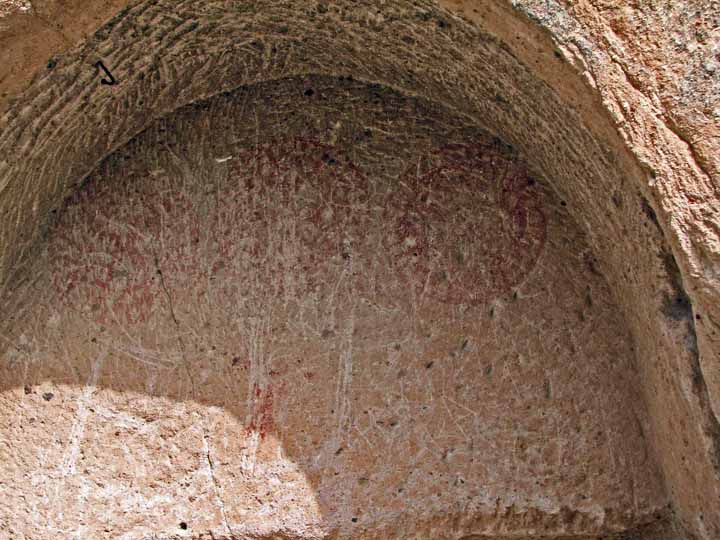
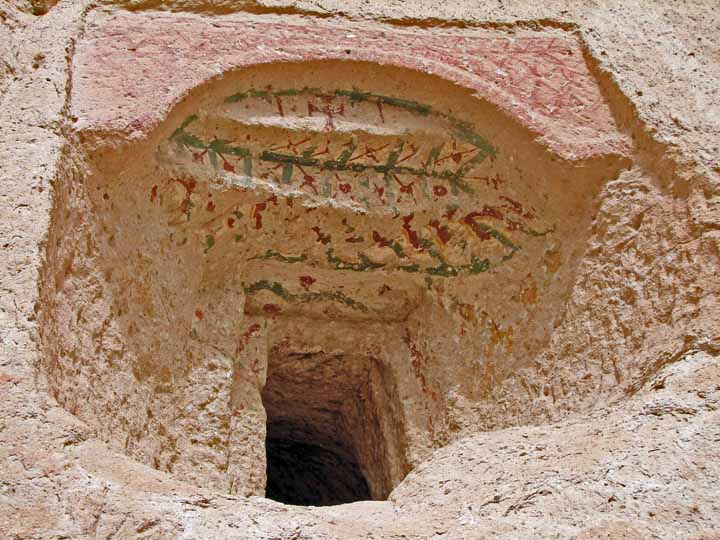
This red and green overlook reminds me of Christmas colors


This is the tower we examined.
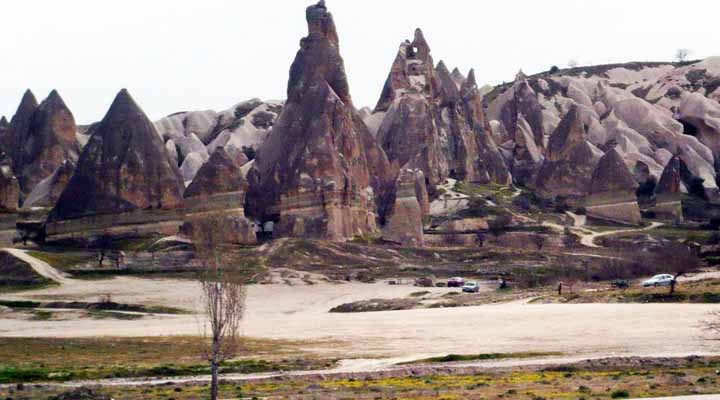
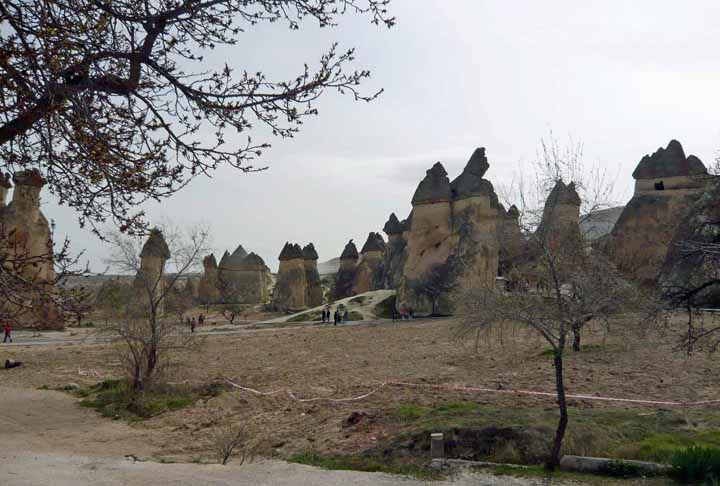

Again - on the road - surrounded by wonder



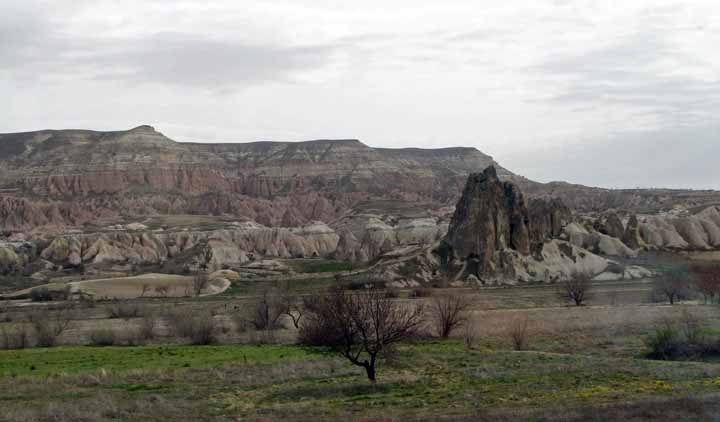
ABSOLUTELY STUNNING - a Cappadocian Grand Canyon
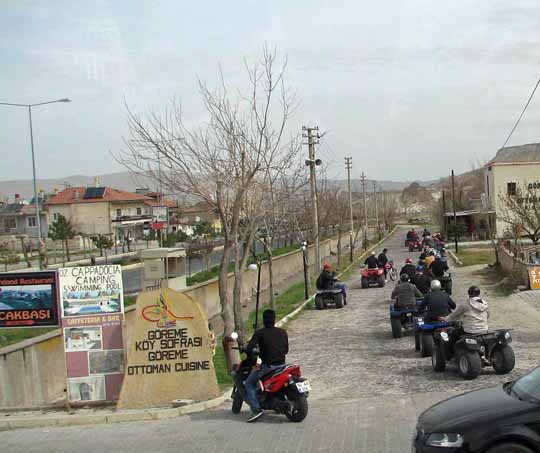 An
other way to tour the area
An
other way to tour the area
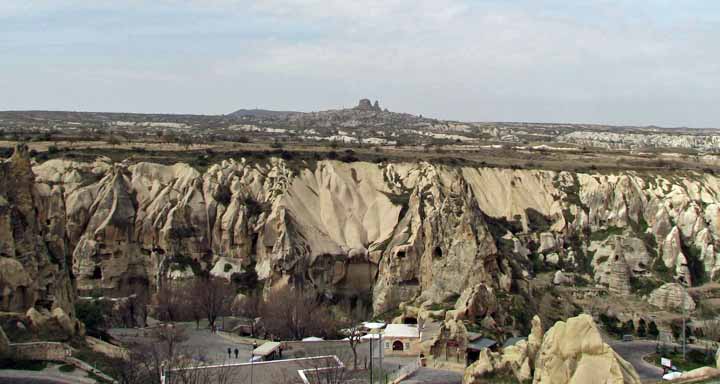
A visitor stop

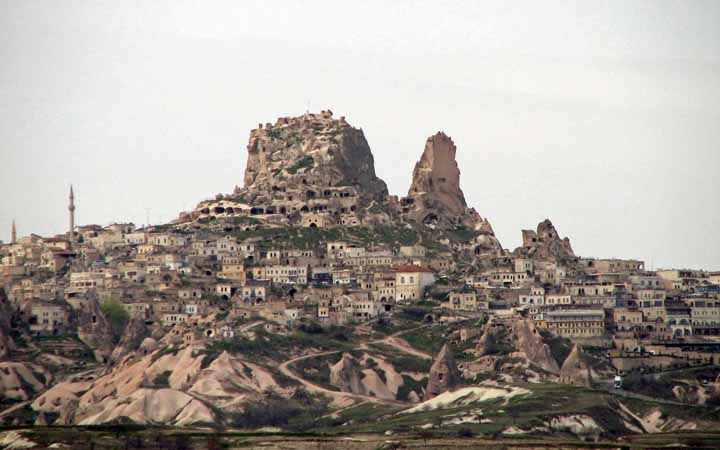
The place called the Citadel in the middle of Old Town

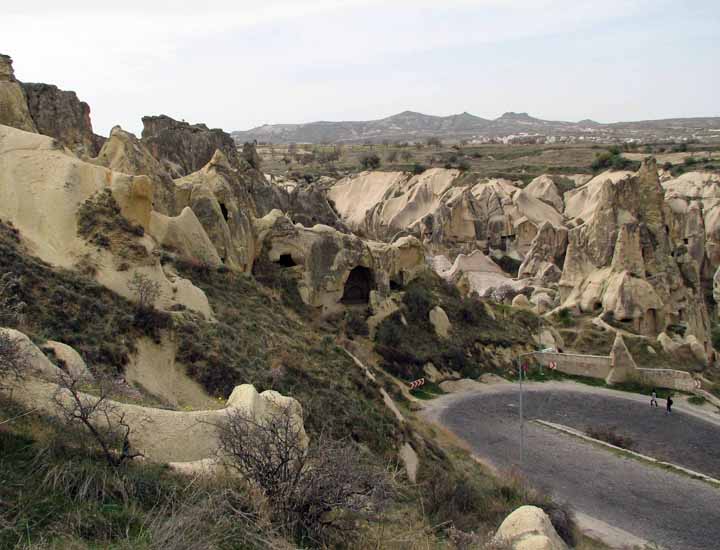
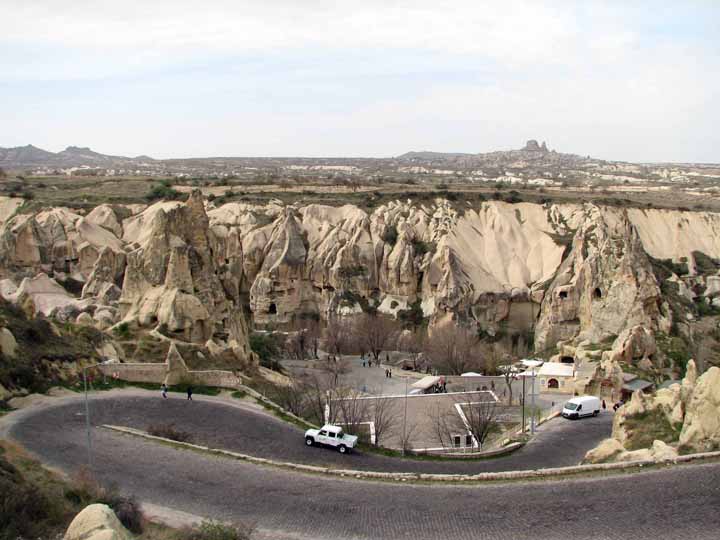
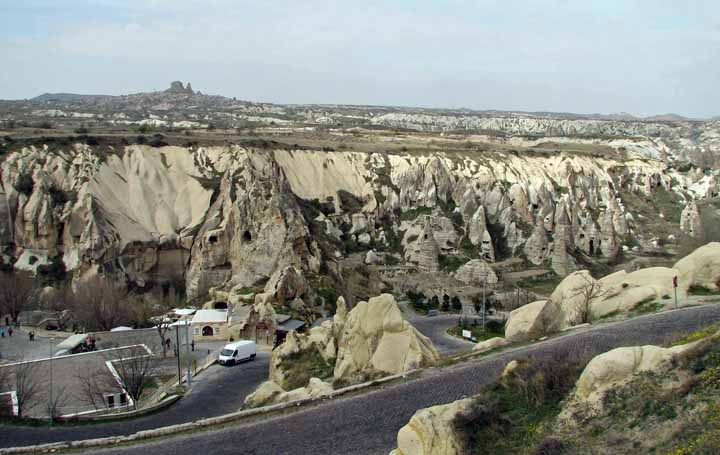
The Rug Factory

Two workers at a loom setting up to get ready to start a rung. This process may take two or more days, depending on the size of the potential rug - without starting a single line of material to weave.

Weaving - the two nearest have pictures of patterns, or the section they're currently working on. The furthest weaver is working without a pattern picture.
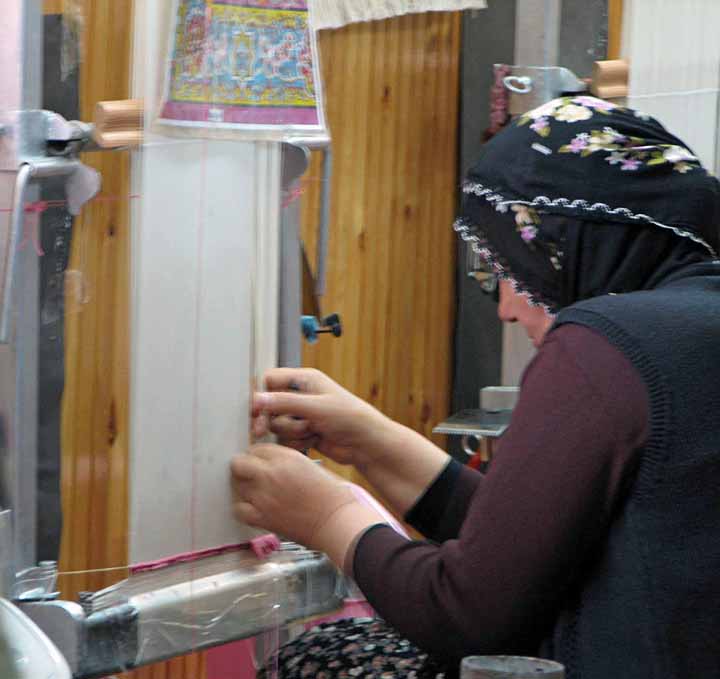 Detailed work - knot after knot.
Detailed work - knot after knot.
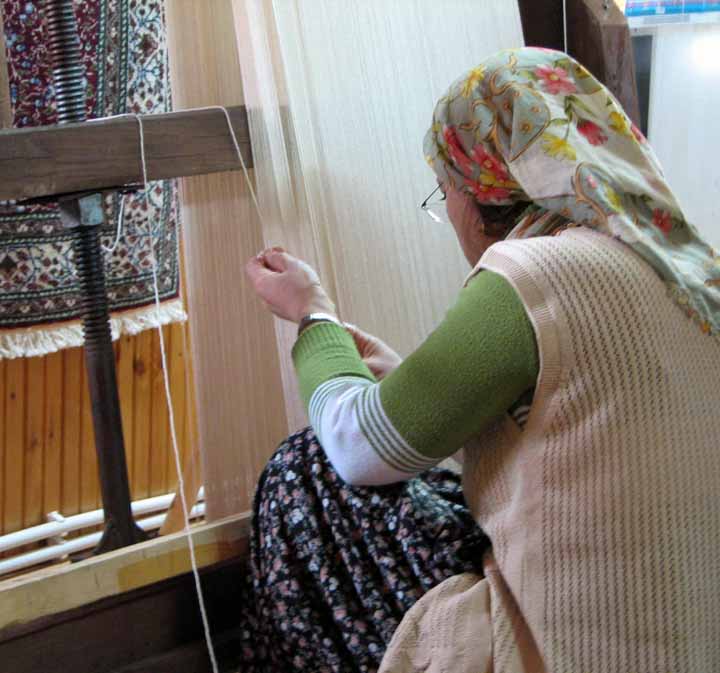
Preparing the core of a rug.
On to the silk room

These are silk cocoon soaking in water to kill the caterpillar pupas and loosen the thread
 A silk pupa, after the caterpillar stage wove the cocoon
A silk pupa, after the caterpillar stage wove the cocoon
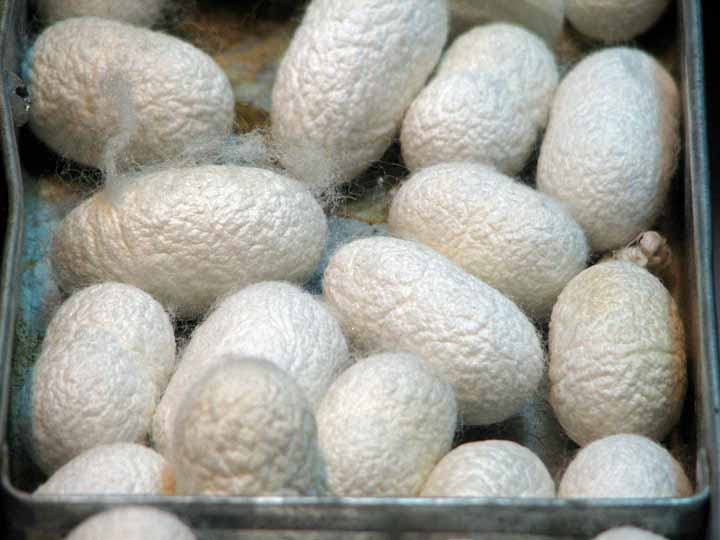 "Raw" Silk
"Raw" Silk
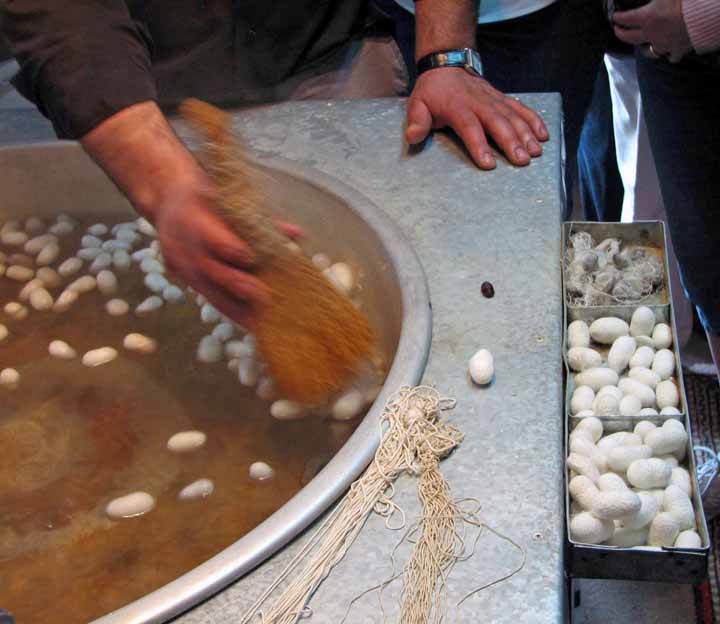
The silk cocoons in the water are brushed very lightly to see if a single thread would stick to the brush

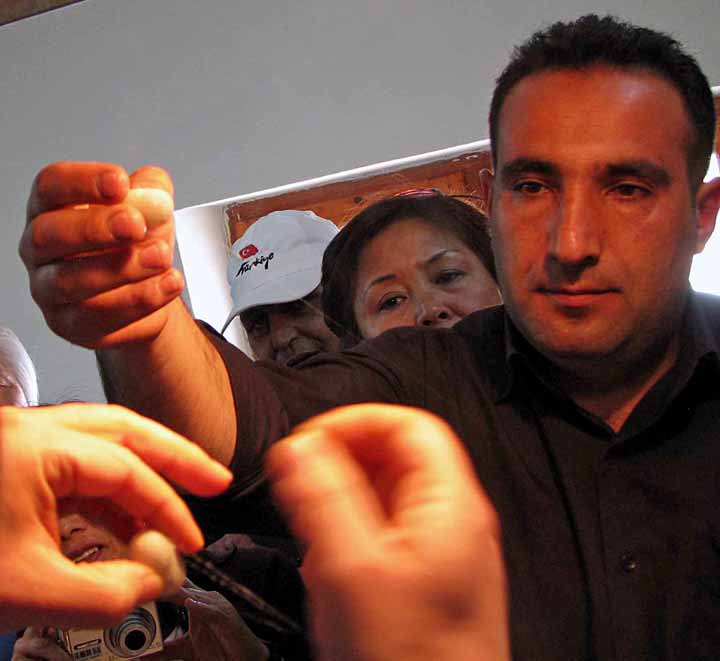 And
a single thread is released - look very carefully at the cocoon in the
presenter's right hand. The single thread goes from his hand, down and to
the right.
And
a single thread is released - look very carefully at the cocoon in the
presenter's right hand. The single thread goes from his hand, down and to
the right.
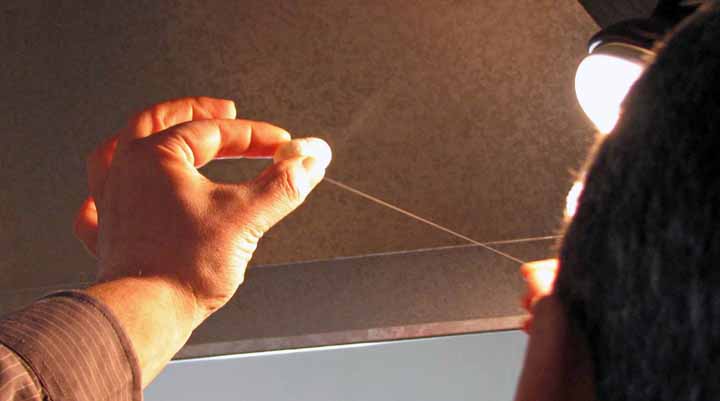
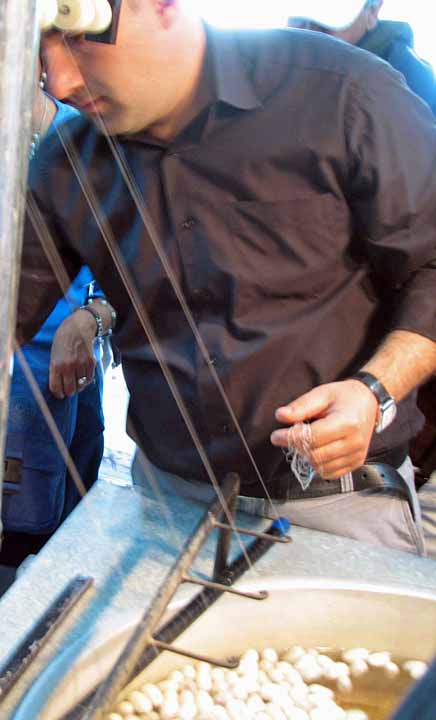 Several
threads, each from a cocoon, are attached to a machine which draws the silk
threads and winds them on large spools
Several
threads, each from a cocoon, are attached to a machine which draws the silk
threads and winds them on large spools
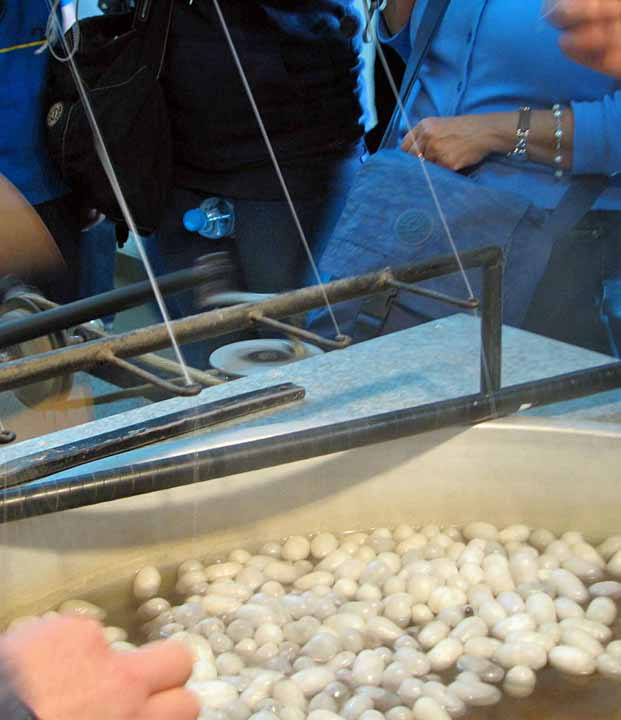
 You
can feel the cocoon spin in your hand as it pulls the single thread to the spool
You
can feel the cocoon spin in your hand as it pulls the single thread to the spool
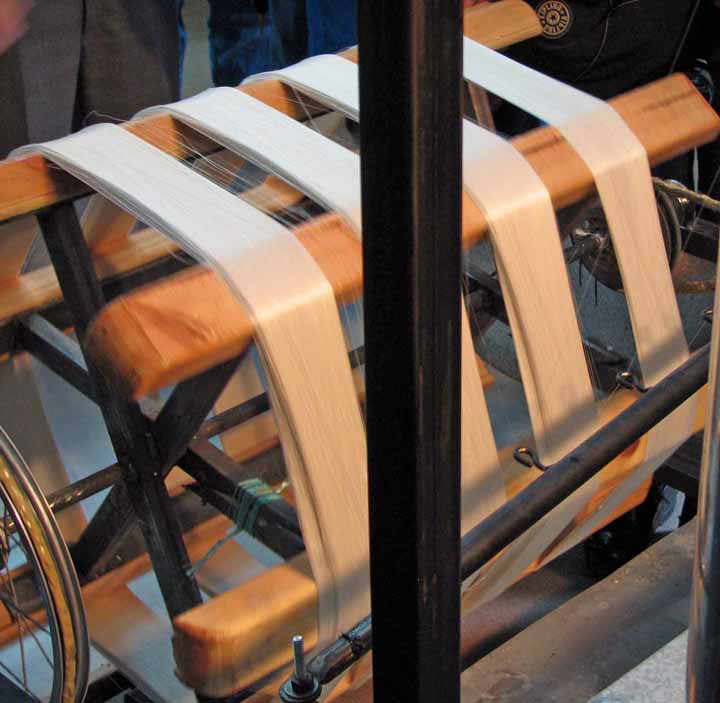
The spools of silk
The was fascinating! I've never seen this process before, even in China - really enjoyed it. The factory does this only as a demonstration. As they use thousands of feet of silk thread, they buy it finished and dyed from commercial sources.
The Rug Room
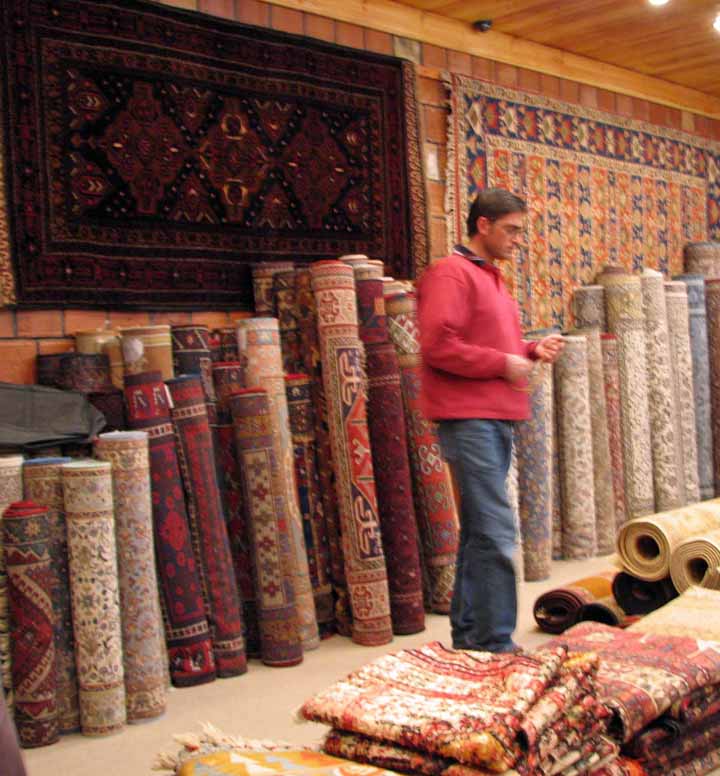 We enter this huge room with benches all the way around three
walls. A huge expanse of floor. We see a large number of rugs
folded and rolled along the front wall.
We enter this huge room with benches all the way around three
walls. A huge expanse of floor. We see a large number of rugs
folded and rolled along the front wall.
First they bring us lunch - more than we could possibly eat and drink. We're all full and then the demonstration / lecture (initial sales pitch) starts.

Prior to lunch
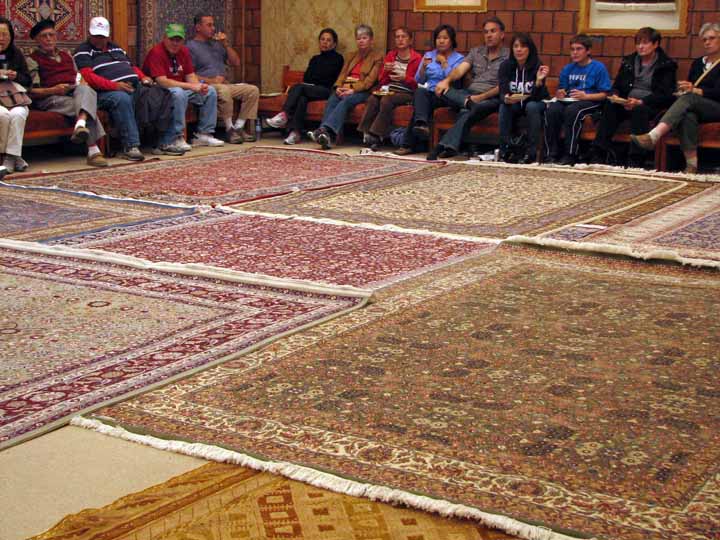
I have a large group of pictures as they spread rug after rug across the floor. I can't imagine the actual number - there may have been over two hundred. Imagine that huge floor four or five deep in rugs! A number of us wanted just to roll around...
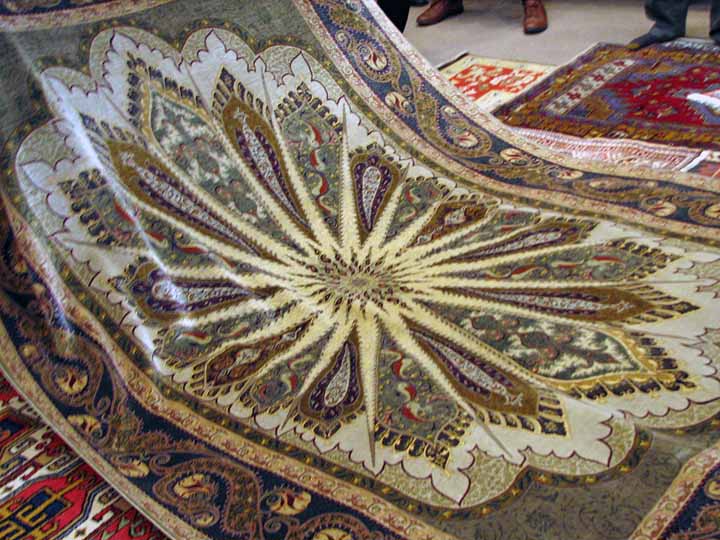
This rug won worldwide rug weaving competition for 2009. This company had won the last four prior years. Te competition is held in Atlanta.
There is no way I could capture the colors. When they unrolled the rug, everyone in the room first held their breach and them you heard a chorus of "Ahh's"

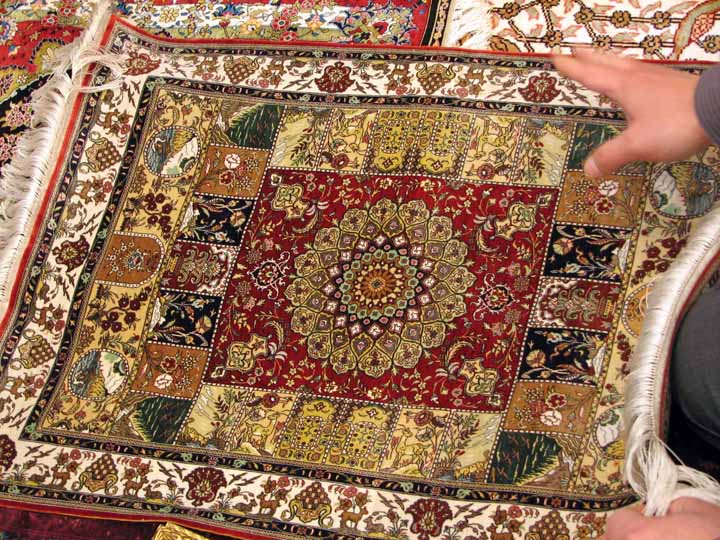
One of their famous silk rugs - as you turn it the knap changes color and gloss.
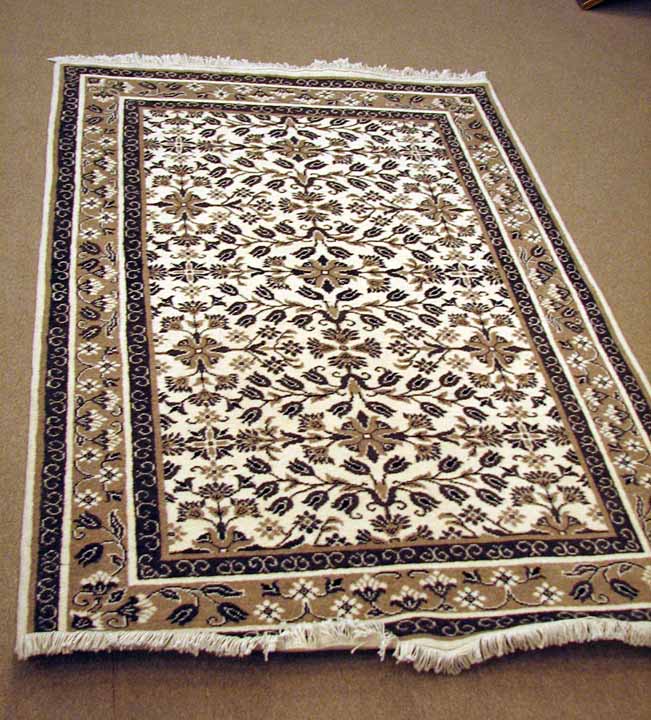
OUR rug.
This rug is natural wool - there has been no dye or color added to a single threat - all are natural sheep's wool colors. Don't want to admit what it cost - BUT there will be no birthday, Christmas, mother's day, father's or Valentine's Day presents into the far future......
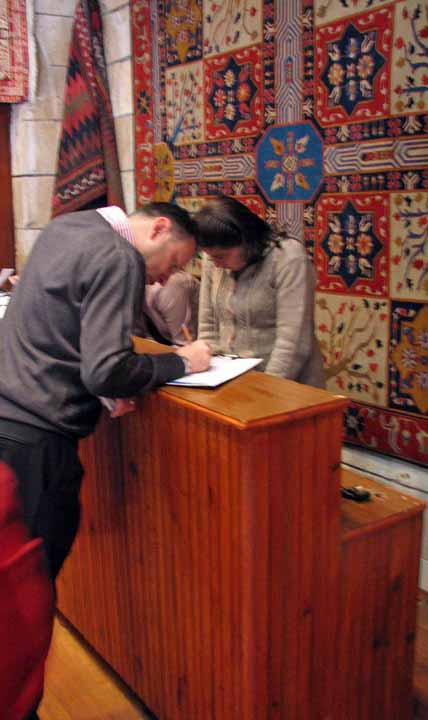 The
friendly staff at the counter, ready to facilitate the sale. The rug you
purchased is brought to the floor before the counter and you are asked to look
at it once again and then sign
and date the label underneath. This allows you to confirm the rug you
wanted and that the rug shipped
and delivered (at no charge) is the one you purchased 6 - 8 week before in
Turkey.
The
friendly staff at the counter, ready to facilitate the sale. The rug you
purchased is brought to the floor before the counter and you are asked to look
at it once again and then sign
and date the label underneath. This allows you to confirm the rug you
wanted and that the rug shipped
and delivered (at no charge) is the one you purchased 6 - 8 week before in
Turkey.
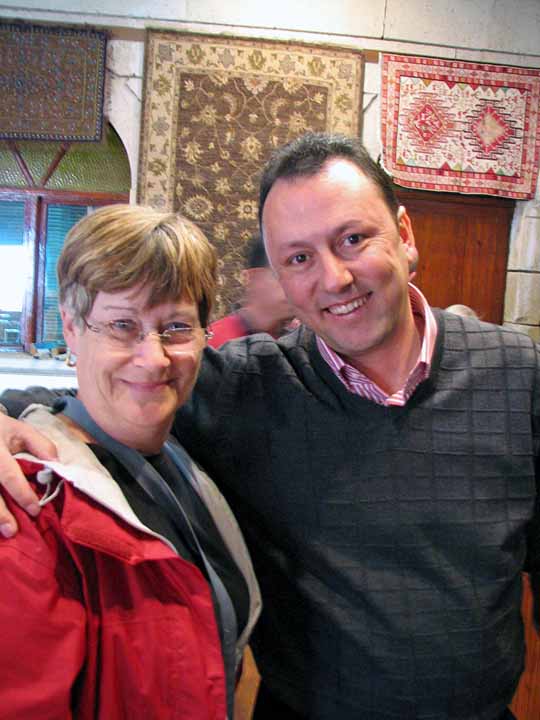
Happy Jackie and an even happier salesman
And we're off again - poorer but happy

As we leave I noticed these "pipes" sticking up. I asked our guide and was told these are underground storage places - sort of like the root cellars we have in our area.

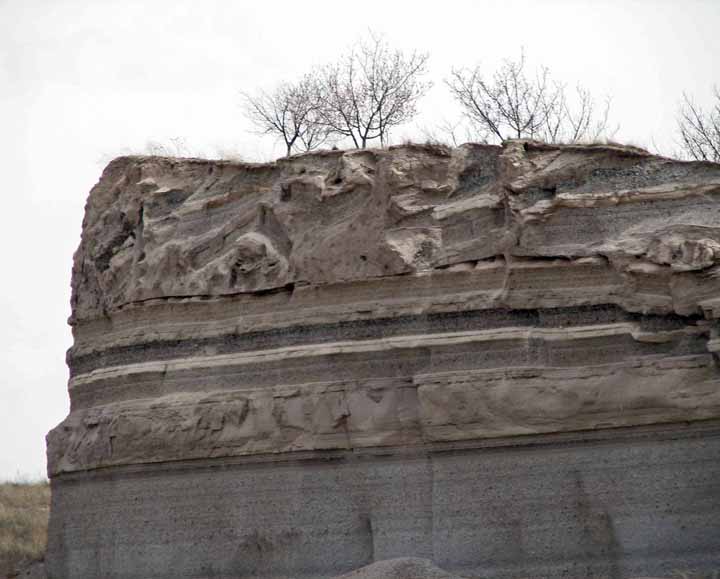
Layer after layer of ash
Kaymakli

There are a number of underground cities in this area. This particular one is the largest by far, and the most popular tourist stop.
This is the single most grievous error we made on this trip. The guide made certain to tell us how tight the passages are - how low the ceilings are - how we must bend double to get through - if we had back, breathing or heart trouble, maybe we should consider not going through - it would take 1/2 hour.
Several of us elected not to go past the first rooms. Bad Error! After the majority of the group went through - everyone said, "yes, it was tight, but well worth it." We goofed by not going. We forgot our travel theme - "We may never pass this way again!"
 In this first room we see an old fountain - one shot with, and
one shot without flash
In this first room we see an old fountain - one shot with, and
one shot without flash

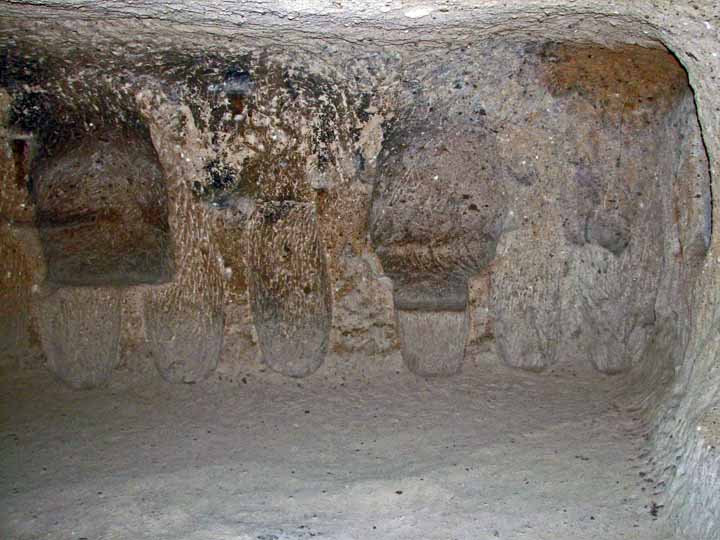
Seating along the far wall.
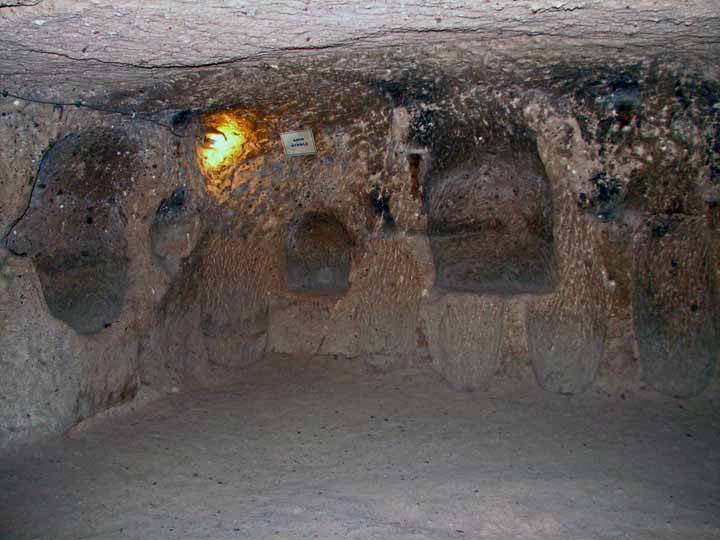
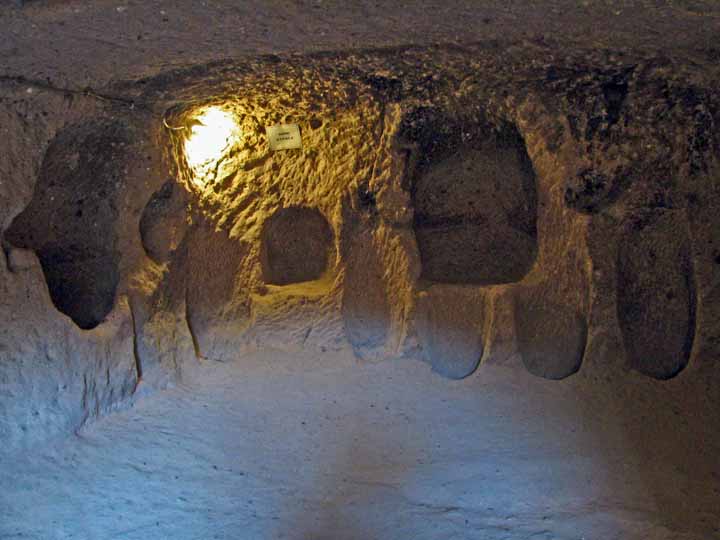
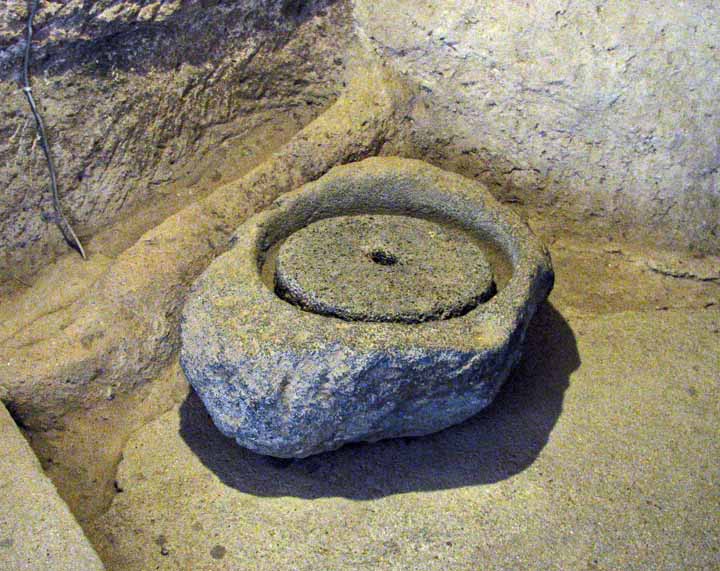 An
old grinding wheel
An
old grinding wheel

While we waited for the tour group to complete the underground city, I wandered down the street and took a couple pictures. A couple older women talking as they watch a cow.
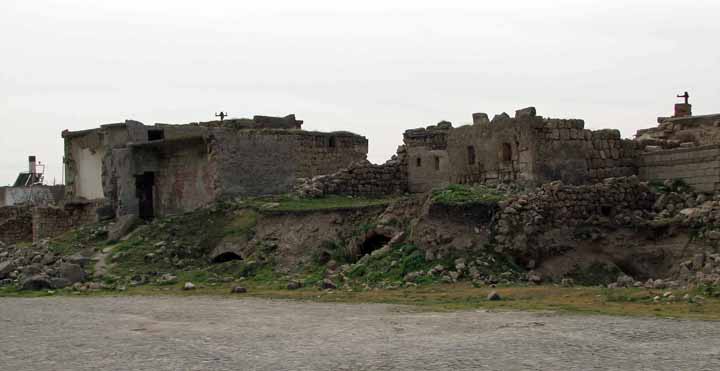
Housing (?) along the road - couldn't tell if they were abandoned or not, or if they were under repair.

 A
group of school boys (I assume) walked past, down the lane. They
stopped and an older man - not in this shot - stopped and the boys sat and
listened as he talked for over 15 minutes.
A
group of school boys (I assume) walked past, down the lane. They
stopped and an older man - not in this shot - stopped and the boys sat and
listened as he talked for over 15 minutes.
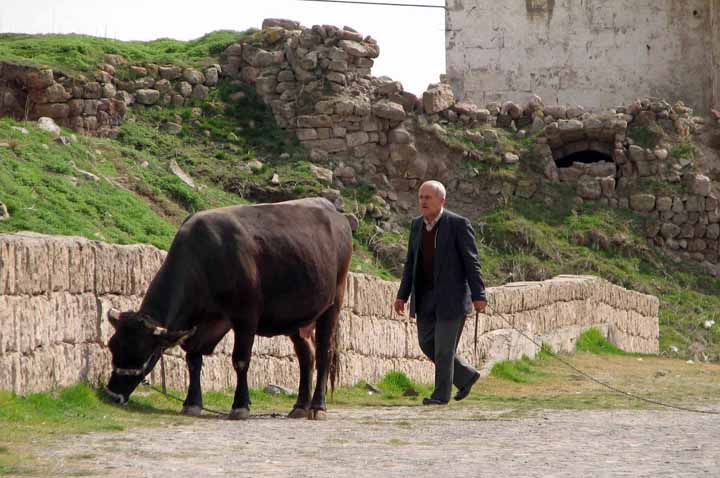
This man led his cow up and down the lane to each grassy spot
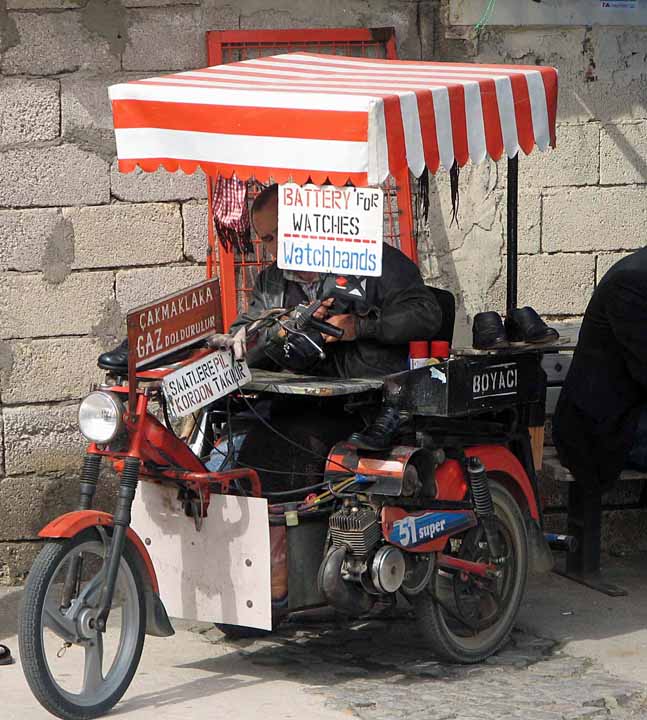
Behind the row of shops above the lane, a man with withered legs drove up in the "Shop Mobile". As you see by his sign, he repairs watches, repairs ands shines shoes.
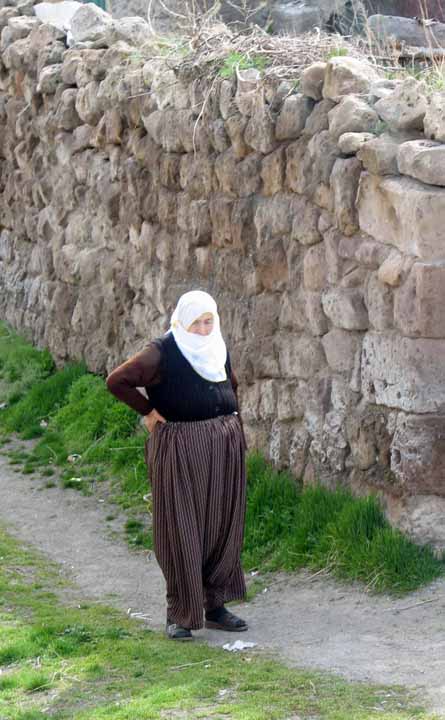 This
lady walked up to the bus, but seems lost in her thoughts.
This
lady walked up to the bus, but seems lost in her thoughts.

I tried, rather unsuccessfully, to get a picture of her skirt - which were actually pants .
PIGEON VALLEY
Now, finally, I'll tell you about all those "mail boxes". Care to guess before I start?
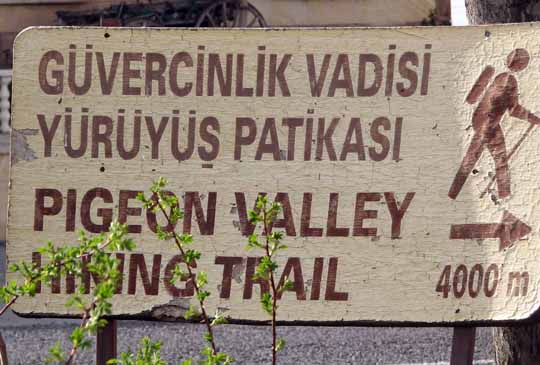
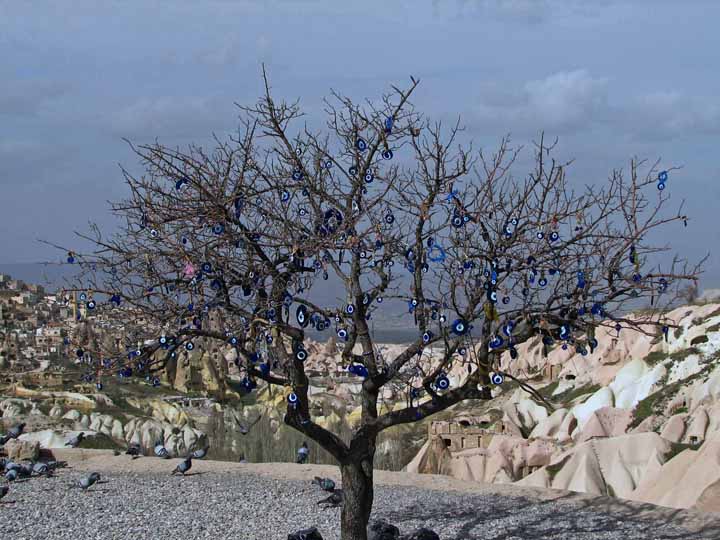
But first, have you ever wondered where all those "evil eyes" come from? Here's an evil eye tree.
By the way, these are not evil eyes, you wear or display these to ward off an evil eye. - a good luck charm. Like me, nearly every driver in Greece and Turkey had one hanging frown a mirror or knob in their vehicle.
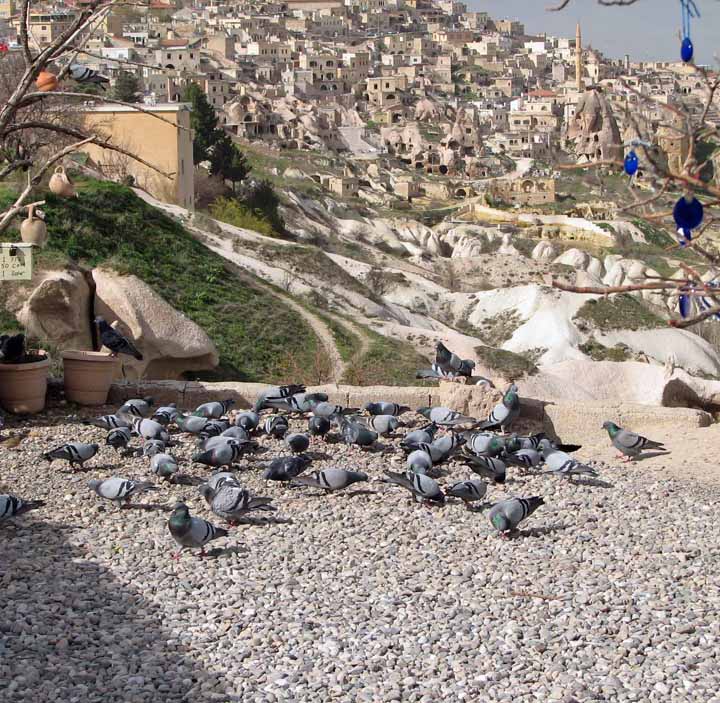
Here we are at Pigeon Valley - close to Old Town. Yes, you are welcome to buy feed and throw it to the pigeons

Old Town. Notice the newer homes mixed in with the cave homes. In the lower center, I was attracted to the home that was a mix, the fairy tower below and the new patio, wall and remainder of the home above.
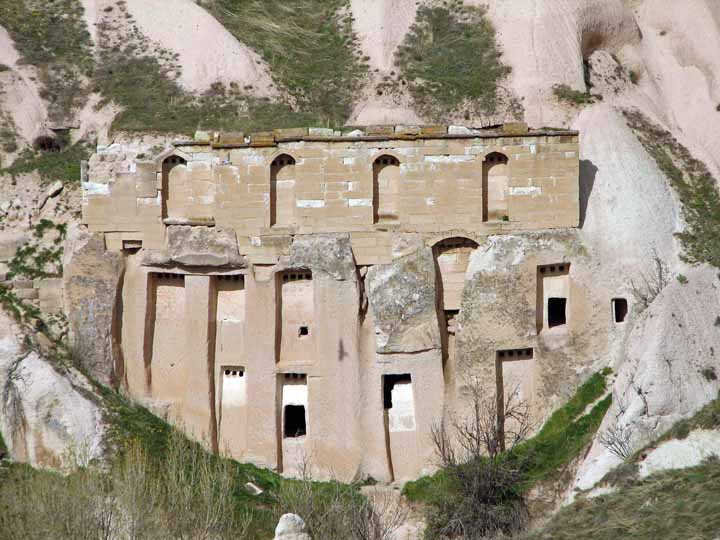
OK - The "mail boxes".
Each of these "apartment" look a-likes hides small opening for pigeons to enter. You can see the small openings - three or four to an "apartment". Inside each has a large number of roosts cut into the wall for pigeons to build nests. In the older sections of town, where you saw the "mail slots", the outer wall protecting the roosts had warn or fallen away.
Where you have that many pigeons, what else do you have? Yep - pigeon crap - mounds and mounds / layer and layers of pigeon crap. Here, this crap is exceptionally valuable. It is used as fertilizer. The grapes in particular require as much fertilizer as possible. The pigeons earn their keep by providing the fertilizer for the Cappadocia Bulls Eye Grapes and the trees which provide the income for these poor farmers.
By the way -
The famous Cappadocian wines are from these "bulls eye" grapes. They have the name because the grapes are inordinately large - "as large as a bull's eye". Hence the name.
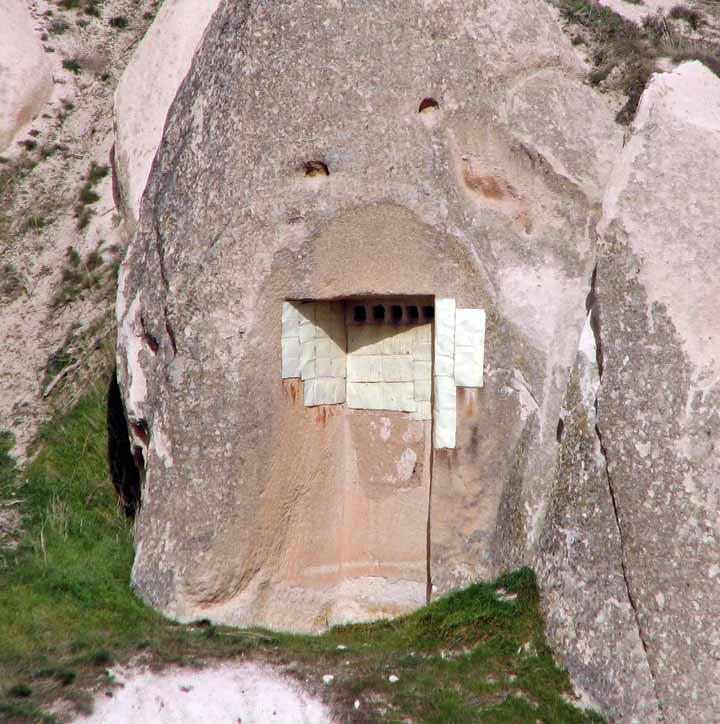
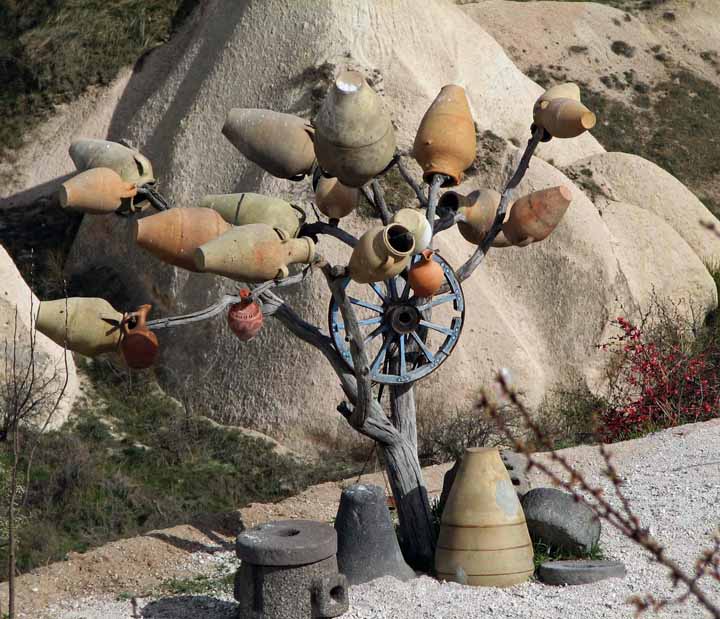
Did you ever wonder where all the pots come from? Why the Pottery Tree, of course!
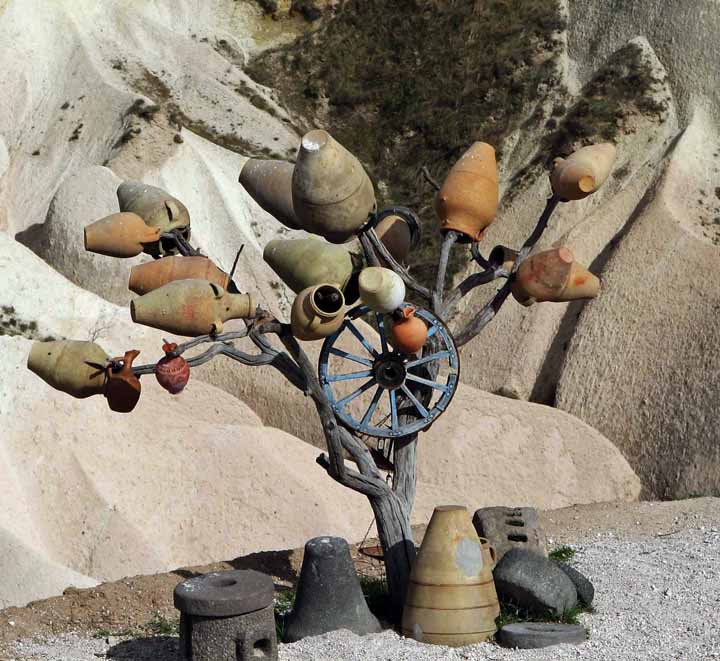
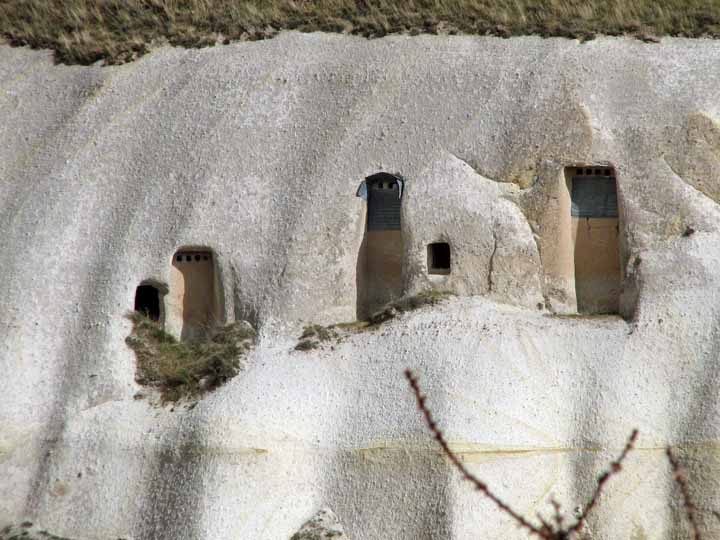
More pigeon roosts - see the door in the lower left? Access to clean out the fertilizer.

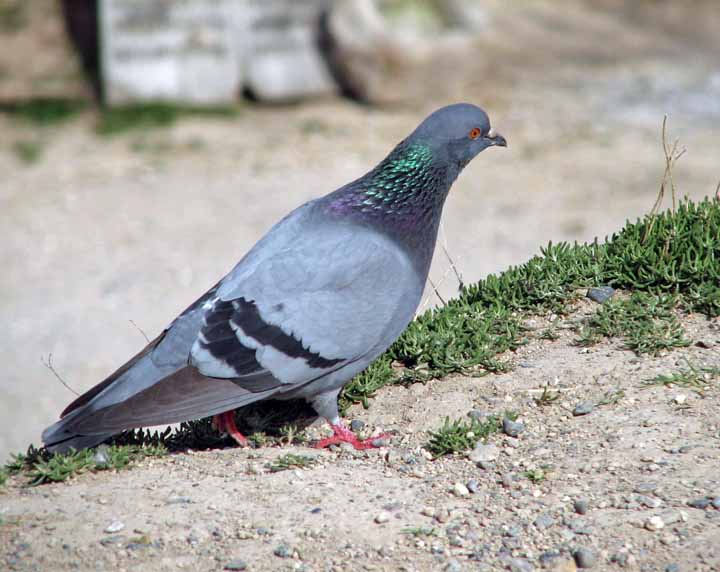
"What cha looking at?"
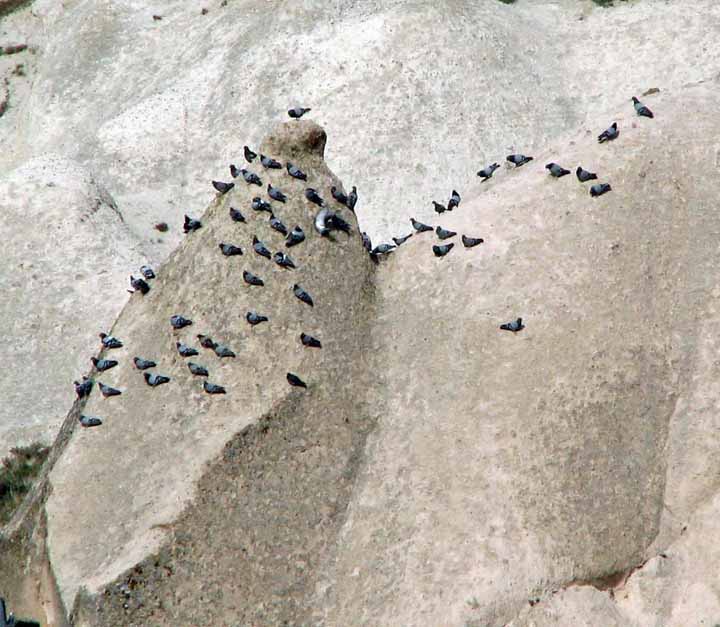 Pigeons
gathered below the roosts on the other side of the ravine.
Pigeons
gathered below the roosts on the other side of the ravine.

Home, sweet home.
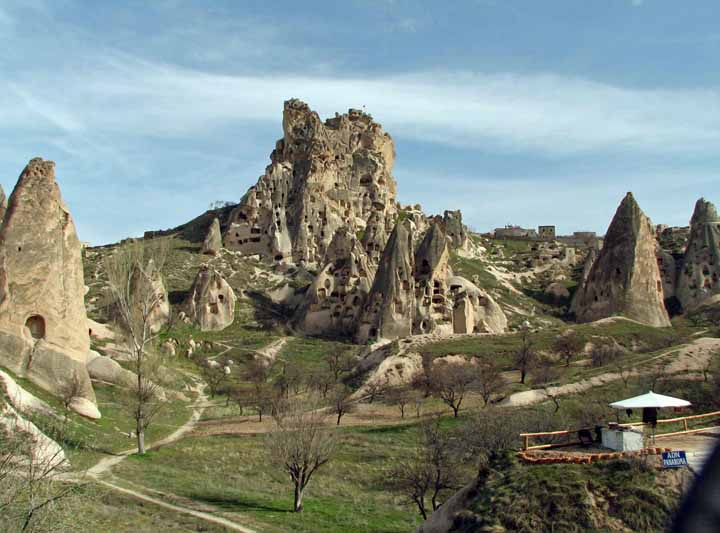
Another stop - another view of fairy towers merged (below) with more modern improvements.

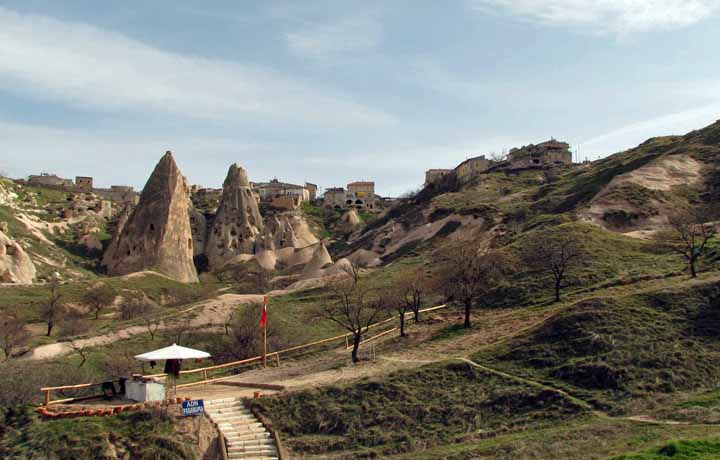

A tower of towers. In this complex one finds homes in the towers, homes built as part or on top of towers, and pigeon roosts. Obviously a multi-functional building.

And at the top - that isn't a house - its a huge cap, with doors, windows and a front lawn.
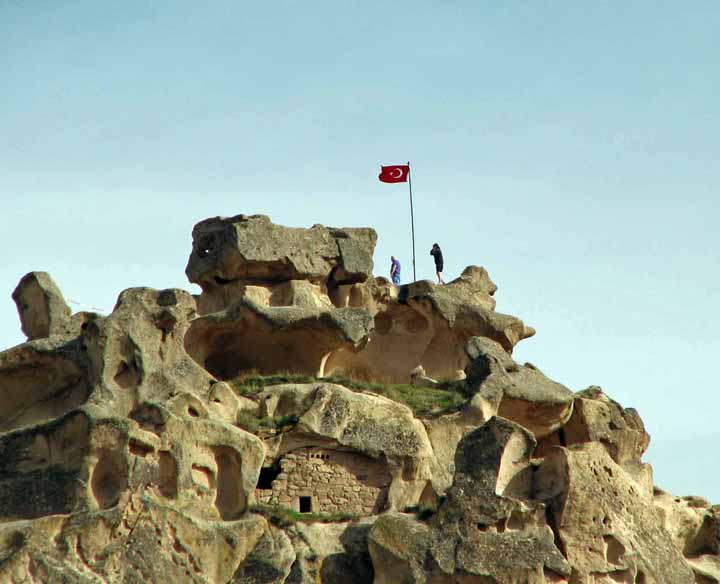

And for those of you who would like to spend some time in leisure in Cappadocia - I give you
The Hotel "1001 Nuits"
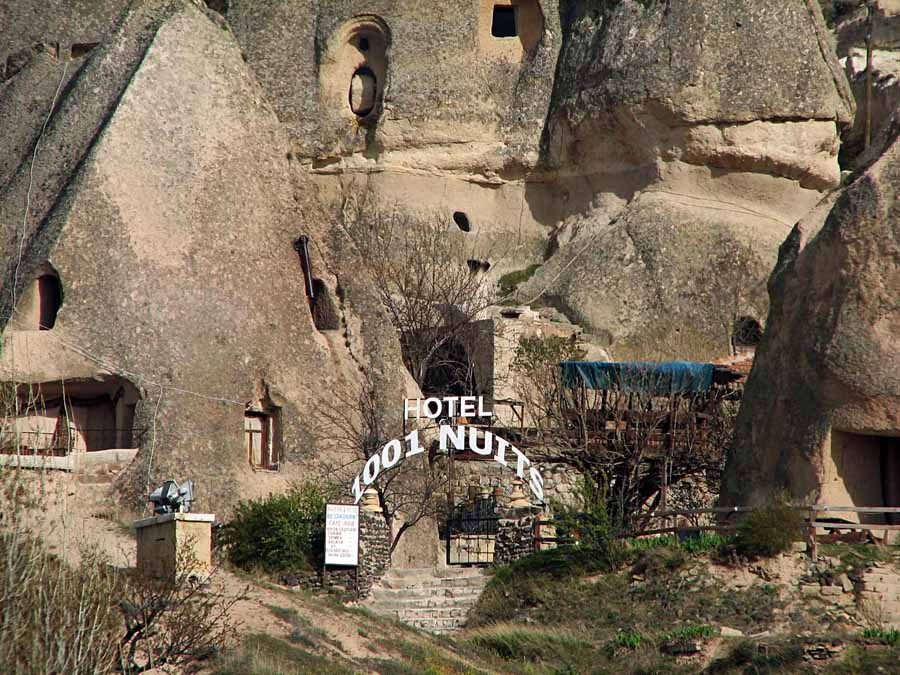
As you see - it has accommodations for a large number of guests, several stories, side buildings, and maybe even a pool.

And we're on our way again. We leave through some beautiful scenery. As many of the fairy towers we've seen, as many of the homes, churches and rooms cut into the towers and the mix of cultures seen in Old Town, every view remain spectacular. We leave looking out the windows......

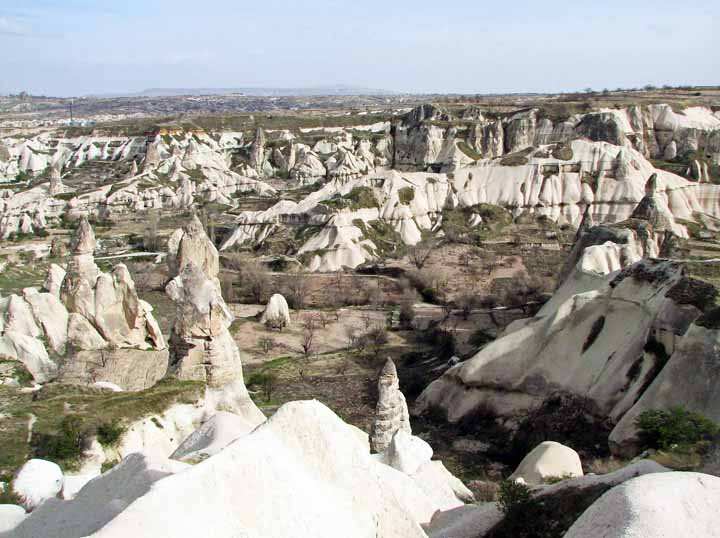
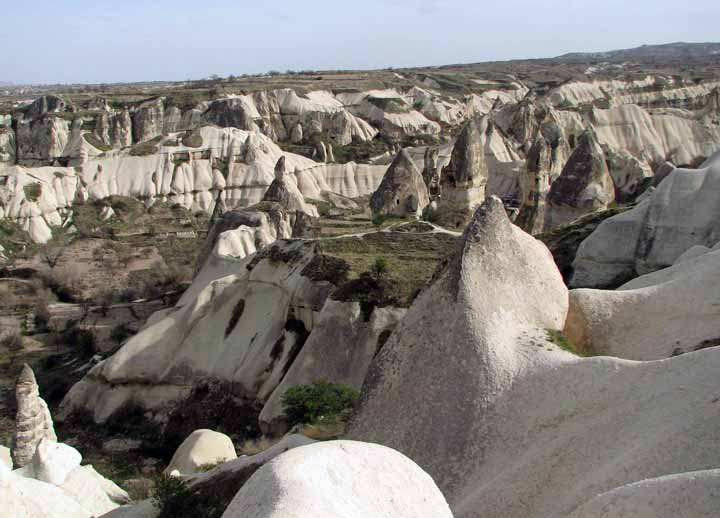
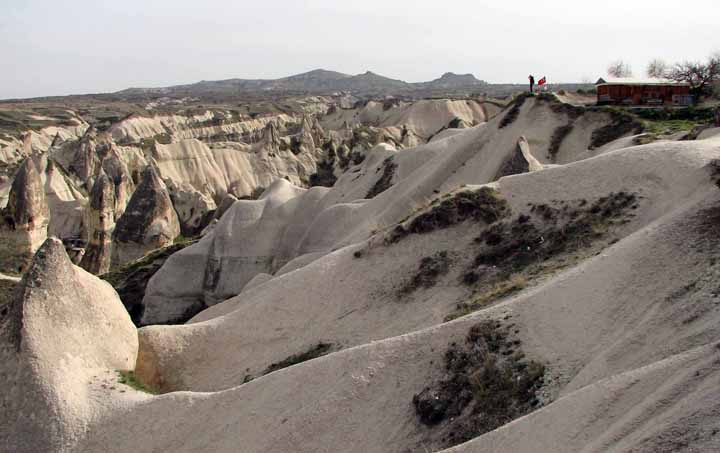

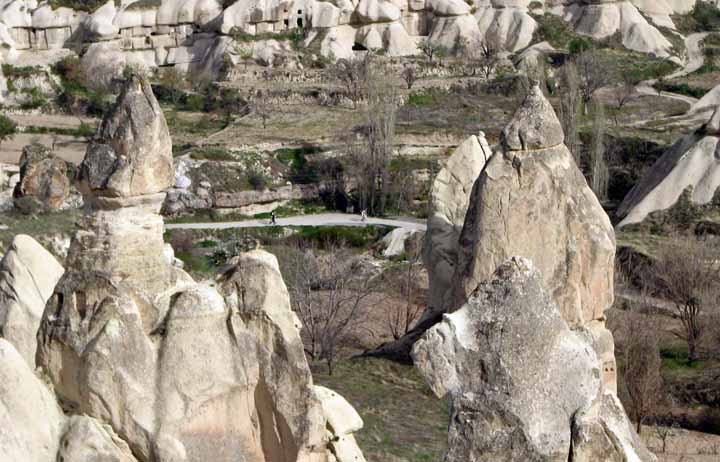
Here we see ( I believe - my notes are incomplete) the Kazilirmak River. It is very famous for providing the clay from which the every day, work-a-day, Turkish pottery is made. From this point, and many like it up and down the river are made pots found all over Turkey.
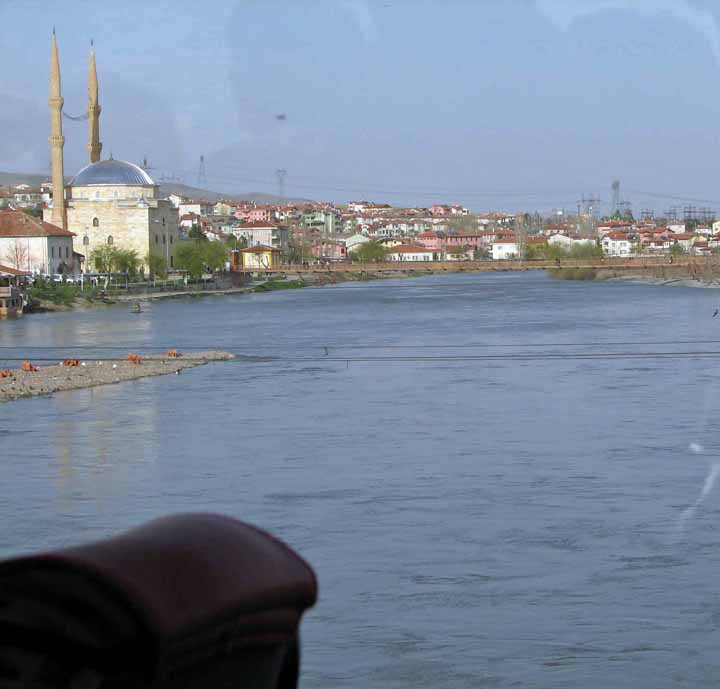

The river was too high to for people to work on the island this day. Some of the pots and forms have washed away, and some are just in the water. I would have loved to see this island when everyone was busy with their forms.

Ah, the hot air balloons!
As you'll recall we saw a single one in the evening sky. We later drive through an area where business after business have their tourist balloon storage, ticket sales and lift off areas.
Below you see only a small number of the balloons crowding the sky. There were easily four times as many in the morning sky. We were told this area has the second largest number of hot air balloons in the world.
What I'd think of as "normal" baskets really were not to be seen. Most of the balloons which were up close, had these metal baskets that looked like rectangular boxes. Not very romantic, but enough to hold a large number of people. I counted over ten people in one of the metal bread baskets. Not for me!

As we leave and go down the valley towards Ankara, we see our last of the volcanoes.
Below you will see (too) many pictures of beautify Mount Erciyes - the largest and most snow covered of the entire chain of volcanoes surrounding Cappadocia. The Hittites worshiped this mountain, calling it "Harkassos" or White Mountain.
All of us were attempting to take pictures of Erciyes from the bus. I had any number that are awful. These were the better ones and I can't bring myself to delete them from the page.....



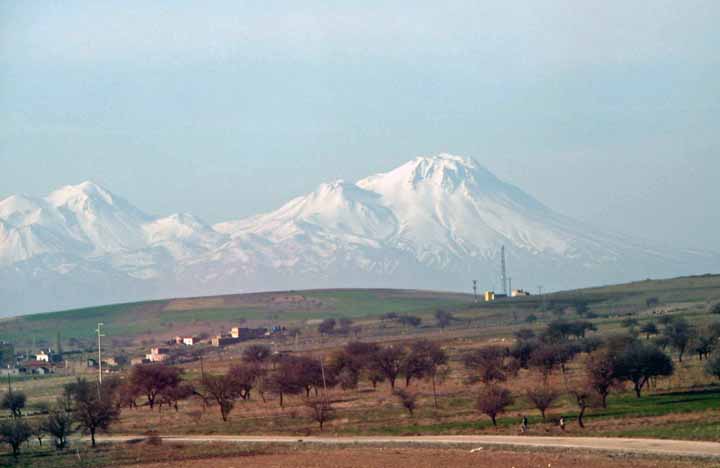
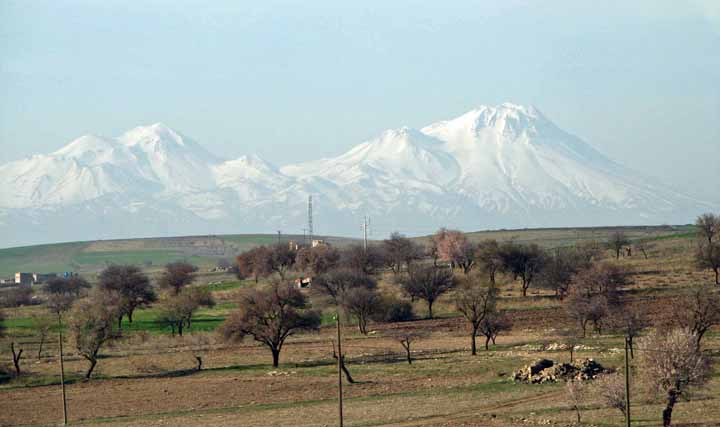
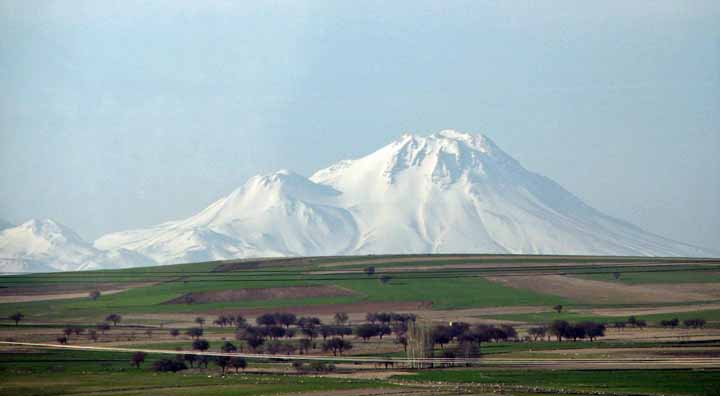



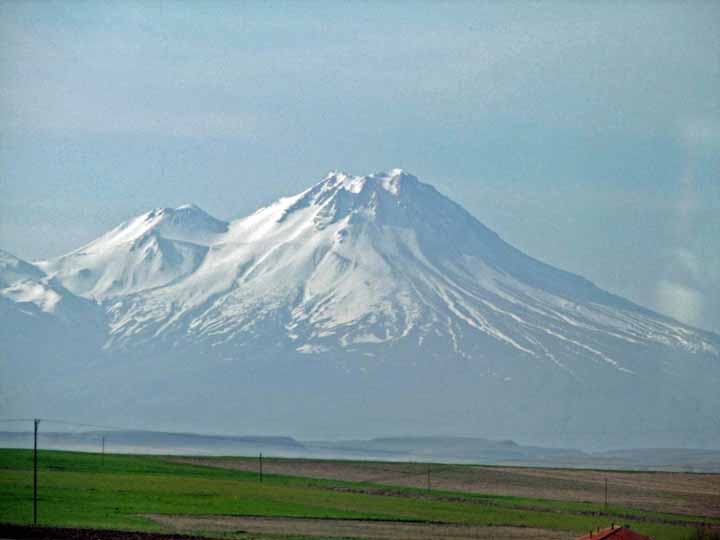
And we leave wonderful Cappadocia